Here is the detailed history of the French Foreign Legion in the Balkans during the First World War. Discover the campaigns of the Legion more or less ignored during the decades, as well as the bravery and the sacrifice of the already forgotten men. Although decimated by enemy artillery or by malaria in Turkey, Greece and Serbian Macedonia, the legionnaires didn’t surrendered. Far from France, in the trenches under the burning sun of Gallipoli or under the snow of the Macedonian mountains, they fought courageously despite everything for the glory of the Legion and for the ultimate victory of the Allies in the Great War.
La version française de cet article: Légion étrangère en Orient : 1915-1919

Introduction
In August 1914, at the beginning of the First World War, France was invaded by German forces. Meanwhile, the Ottoman Empire (present-day Turkey) secretly signed a treaty of alliance with Central Powers (the German Empire and Austria-Hungary) against the Entente (Allied Powers – France, the United Kingdom and Russia). At the end of October 1914, Turkey went to war: the Russian naval installations at Odessa, Sevastopol and Novorossisk were attacked. As a result, a French liner was damaged and a Russian gunboat was also sunk. Also, the Dardanelles (or Dardanelles Strait), a natural strait that separates Europe from Asia, was closed by the Ottomans. The strait is a maritime passage which allows to control the connection between the Mediterranean Sea and the Black Sea, and the only possible way to supply Russia with materiel at the time. An Allied campaign in Southeast Europe was therefore planned for the year 1915 to seize the strait.
For this campaign, a new French division would be formed, with provisional regiments. One of these regiments was formed in North Africa, consisting of legionnaires and zouaves (French soldiers recruited among the European settlers in North Africa).
Foreign Legion Battalion and the 1er RMA
The Foreign Legion Eastern Battalion was organized in Algeria, on March 1, 1915, to form part of a new combined regiment that had been formed in Africa for the front in the Balkans. The Battalion was composed of a HQ and four companies. Two companies were provided by the 1st Foreign Regiment (1er RE), another two by the 2nd Foreign Regiment (2e RE, now 2e REI). Among the 1,124 men, there were a number of Italians. Major Louis Geay took command. This officer was not a pure Legion officer. He had served only a few months with the institution before taking over the battalion. Since 1904, he had commanded Algerian tirailleurs (native infantrymen recruited by the French).
Foreign Legion Eastern Battalion in March 1915
- Commander: Major Geay
- HQ: Lieutenant Royer
- Machine Gun Platoon: Lieutenant Dumenieu
- 1st Company: Captain Rousseau
- Lieutenant Hamot
- Lieutenant Bouhelier
- 2nd Company: Captain Kelsch
- Lieutenant Gully
- Second Lieutenant Beck
- 3rd Company: Captain Cao-Van
- Lieutenant Chavanne
- Lieutenant Timm
- 4th Company: Captain Bernois
- Lieutenant Bisgambiglia
- Second Lieutenant Voigt
The Legion Battalion would constitute, along with a battalion from the 3rd Zouaves and a battalion from the 4th Zouaves, the 1st African Provisional Regiment (1er RMA), commanded by Lieutenant Colonel Desruelles. This combined war-time only unit would be part of a new divison organized for the front in Southeast Europe.
The Legion Battalion became administratively the 3rd Battalion, 1er RMA.
For the following campaign, the 1er RMA was assigned to the 1st Metropolitan Brigade of General Vandenberg (who served with the Legion in 1897-1901 and 1912-13), along with the 175th Infantry Regiment (175e RI). The latter was led by a certain Lieutenant Colonel Forey. This officer joined the Legion as a sergeant in 1884 and was promoted to officer rank in Tonkin (Indochina) two years later. In 1918-19, he would become the commanding officer of the 1st Foreign Regiment. In 1946, doyen of the legionnaires, Colonel Forey would carry the hand of Captain Danjou during the celebrations of Camerone.
The 1st Metropolitan Brigade was attached, along with a Colonial Brigade (four Senegalese battalions + two European battalions of Colonial Regiments) and artillery + engineering elements, to the newly established 1st Division of General Masnou. Then the division was the only unit of France’s East Expeditionary Force (CEO), led by General Albert d’Amade. Lastly, the French CEO was a part of the Mediterranean Expeditionary Force, an allied joint force commanded by British General Sir Ian Hamilton.
On 2 March 1915, the Battalion left Algeria for the Balkans. It stopped over in Lemnos (a Greek island in the Aegean Sea) until 26 March and in Alexandria (Egypt) until 10 April. The regiment continued its training there and received its flag. On April 11, the Legion Battalion took ship for Lemnos to be followed a week later by the rest of the regiment, now under the command of Lt Col Foulon.
Since April 24, the Allied forces had been concentrated on the island of Tenedos (now Bozcaada, a Turkish island in the north of the Aegean Sea). They were composed of the French, British and ANZAC (Australian and New Zealand) troops. The Allies planned to land in the south of the Gallipoli peninsula (European part of the then Ottoman Empire) to take control over the Strait of the Dardanelles. The Gallipoli peninsula comprises the northern, European shore of the strait. A large landing operation would take place on 25 Avril 1915.

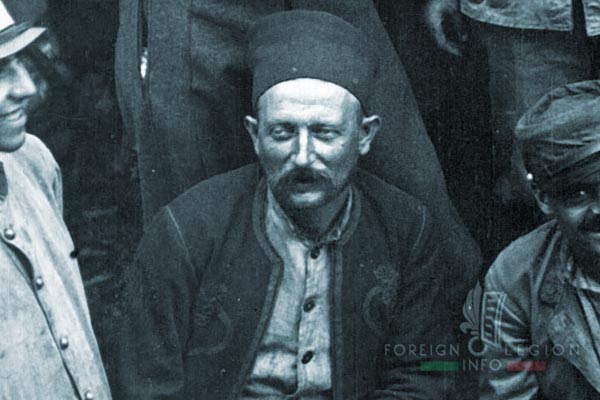

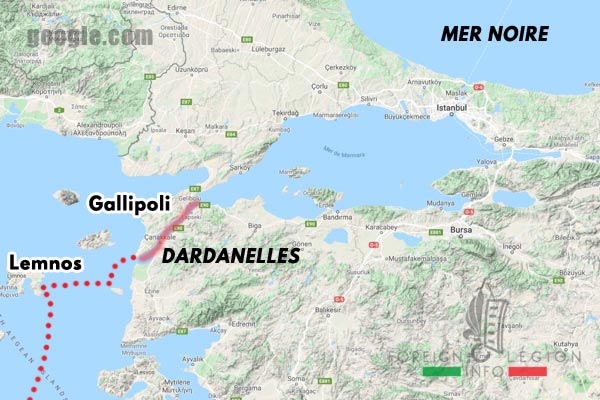
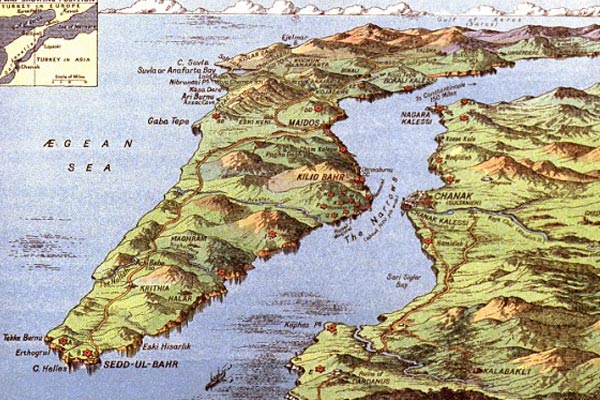
Gallipoli campaign
On 25 April 1915, the Gallipoli campaign (also the Battle of Gallipoli or the Dardanelles campaign) began. The landings were carried out by the British and ANZAC units on six beaches, in the south and in the north-west (ANZAC) of the peninsula. The British had to take control of Cape Helles and advance toward Krithia (Alçıtepe now, a village 6 km north of Cape Helles) and Achi Baba, a height dominating the peninsula, situated north-east of the village. For the Allies, these were the two most important points to achieve. At the same time, the French of the Colonial Brigade were carrying out an attack at Kumkale, a village on the Asian shore of the Dardanelles strait, as a diversion from the main landings on the Gallipoli peninsula. The 1er RMA’s Metropolitan Brigade and other units were kept in reserve.
On April 27, the Ottomans counter-attacked the six ANZAC brigades, without success. In the evening, another part of the Allied forces landed at Cape Helles, near Sedd el Bahr, a village marked by an old fortress.
Finally, in the morning of April 28, the 1er RMA was to land, with its Legion Battalion (3rd Battalion). The regiment landed on “S” beach at Morto Bay, located north-east of Sedd el Bahr.
From Morto Bay to Achi Baba, the rising and gullied terrain was difficult for offensive forces. Four ravines (deres) ran from Achi Baba toward the bay and the Cape. To the east, there was the Kereves Dere ravine which flowed into the Dardanelles to the north of Morto Bay. This sector was assigned to the Metropolitan Brigade with the 1er RMA. Shortly after the landing operation, the Allied forces were ready for launching an offensive to take over Turkish positions around Krithia.
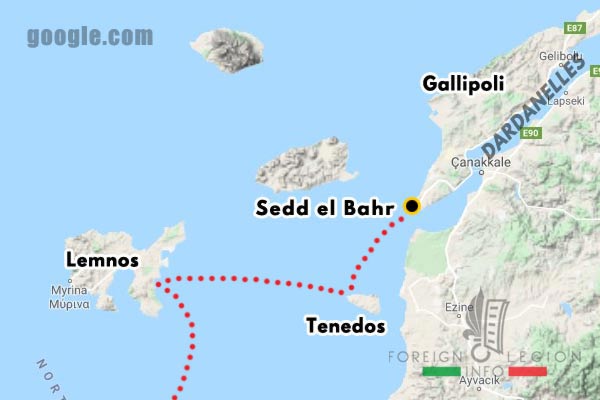

First Battle of Krithia (28 April – 4 May 1915)
The main Allied assault began at 8 a.m. (08:00). In the west of the peninsula, it was led by the British 29th Division. In the French sector, the assault was led by the Legion Battalion, alongside another battalion of the 1er RMA and a battalion of the 175e RI. The three battalions advanced toward the Kereves Dere ravine, which would be reached at 4 p.m. (16:00). There, the Turks were well entrenched with their artillery and machine guns. The battle started. It was violent and the losses increased very quickly. The enemy counter-attacks were repelled only by furious bayonet charges. Eventually, around 8 p.m. (20:00), the fighting had lost its intensity and the legionnaires and zouaves took charge of the conquered positions. For this single day, the losses of the Legion Battalion are 8 officers wounded and 100 legionnaires killed or wounded. The British and the French forces only progressed some 2 miles (3 km) at the cost of around 3,000 casualties.
On the night of May 1, the Turks launched a heavy counter-offensive against the positions of the two French brigades. The Turks were attacking en masse to throw the Expeditionary Force back to the sea. But thanks to the decisive resistance of the Foreign Legion Battalion and their brilliant bayonet charges, led by Adjudant-chef Léon, a Warrant Officer from the 1st Company, the situation would soon be restored. Shortly afterwards, a major counter-attack of all French troops was ordered. The Ottomans were driven back to their initial positions. On May 2, reduced to a handful of brave men commanded by Lieutenant Bouhelier, the Legion Battalion still cleared the trenches into which the enemy had penetrated. Lieutenant Bouhelier, the last combat-ready officer of the Battalion, was wounded in turn.
The losses were significant for the 1er RMA. Almost all officers of the regiment were killed or wounded, including the colonel and battalion commanders. Captain Squinet took command of the 1er RMA (then consisting of only four combat companies in total).
During the previous two days, the Legion Battalion lost 4 officiers wounded and 190 legionnaires, wounded or killed. The heavily reduced Battalion was now headed by Adjudant-chef Léon, the highest-ranking non-commissioned officer.
In the following days, the Ottomans would continue to shell vigorously the French positions. The enemy infantry fired constantly as well. On the night of May 4, the 1er RMA repelled a number of Turkish counter-attacks.
As of May 5, Lieutenant Colonel Niéger took command of the 1er RMA. The same day, reinforcements arrived to restore the regiment.
Adjudant-chef Léon got a battlefield commission. He was promoted to the rank of Second Lieutenant on the battlefield and would be awarded with the Legion of Honor. Lieutenant Salomon took command of the Legion Battalion. These two men were the only combat-ready officers of the Battalion at the time.
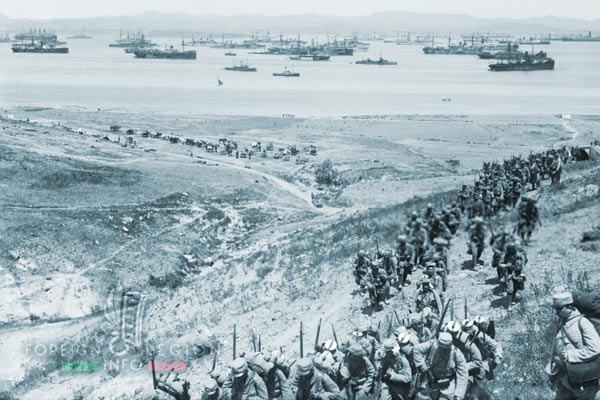

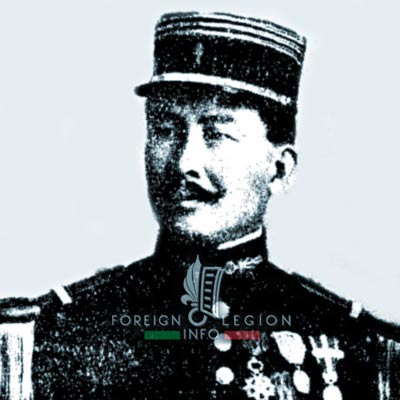
Battle of Krithia – Kereves Dere (5 May – 13 July 1915)
1st Attack of Kereves Dere (6-9 May 1915)
On May 6, the Allied forces again attacked the Turkish positions of Krithia – Achi Baba. The 1st Metropolitan Brigade was ordered to occupy the elevation of the terrain of the Kereves Dere. The losses during the advance of 2,000 yards (1,800 m) were horrendous, but the objective were reached. The legionnaires removed two more Ottoman trenches.
Nevertheless, on that day, the British only progressed 550 yeards (500 m) and suffered 6,300 casualties.
From May 8 to 9, the Allied attempt to advance continued. France’s 1st Division of General Masnou removed the spur of Kereves Dere and the ANZAC troops removed first Ottoman trenches situated around Krithia.
During these ten days of merciless and relentless struggle, the legionnaires and zouaves were competing in enthusiasm and heroism. Unfortunately, almost all officers and NCOs of the 1er RMA were killed or wounded again, and therefore many acts of bravery would remain forever unknown.
On May 9, a small reinforcement arrived to restore the Legion Battalion.
Since May 10, the Allies had been firmly established on the Gallipoli peninsula. The 1er RMA units were still guarding the sector on the edge of the strait, very exposed to shelling from the enemy positions of Achi Baba and from the Asian coast on the opposite side.
In mid-May, General d’Amade, sick, was replaced at the head of France’s East Expeditionary Corps (CEO) by General Gouraud.
On May 25, a reinforcement of 4 officiers and 350 legionnaires arrived. The Legion Battalion was reformed; Captain James Waddell assumed command. New Zealander, he had joined the Legion as a Second Lieutenant in 1900, after having left the British Army.
Also in late May, the 2nd Division (General Bailloud) arrived in the Dardanelles to reinforce the CEO, including the 2e RMA. As of May 29, the 1er RMA battalion of the 3rd Zouaves was therefore replaced by a 2e RMA battalion of the 4th Zouaves. Since then, the 1er RMA had been composed of the Legion Battalion and two battalions of the 4th Zouaves.
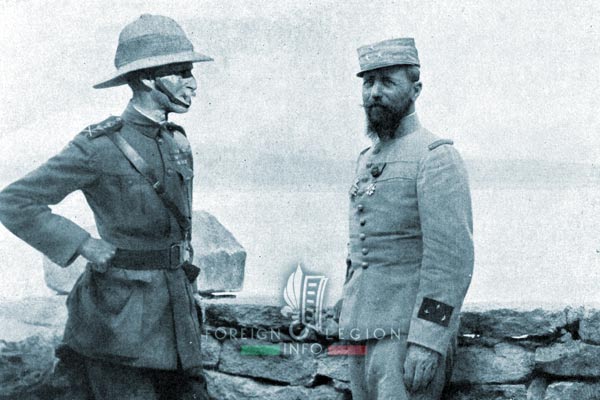
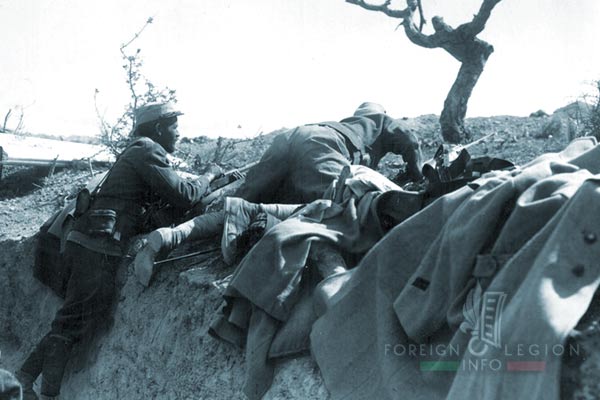
Attack of Le Gouez redoubt (30 May 1915)
The French troops, including legionnaires, occupied the eastern side of the line along the Dardanelles shore and the ravine (spur) of Kereves Dere. They faced the strongest Ottoman defenses, dominated by four redoubts. Meanwhile, the French managed to capture one of the redoubt, Le Gouez.
On 30 May, the redoubt was occupied by the Legion company of Captain Solomon. In the evening, the legionnaires would be confronted with three successive Turkish attacks carried out in less than two hours. The attacks were serious and the Legion company would be quickly reduced. Before succumbing to the enemy, a reinforcement led by Captain Waddell came to support the defenders. They immediately counter-attacked the Ottomans and threw them out of the redoubt. At midnight, another bloody assault occurred. The legionnaires, commanded by Captains Waddell and Solomon, conducted a successful bayonet charge and definitively drove the enemy out of the redoubt. However, 21 of their comrades were killed and 53 wounded.
2nd Attack of Kereves Dere (4 June 1915)
The combined British/French offensive toward Krithia continued on June 4 (Third Battle of Krithia in British sources). About 30,000 men attacked on this day. Despite heavy losses, the legionnaires advanced toward the enemy, but their ranks were broken and nailed to the ground by Turkish machine guns. That day, the Legion suffered 23 men killed and 78 injured. In the evening, the assault was suspended. The Allies only gained a few hundred meters. About 3,000 Ottomans were killed.
Foreign Legion Battalion in mid-June 1915
- Commander: Major Waddell
- Machine Gun Platoon: Second Lieutenant Maillet
- 1st Company: Lieutenant Polli
- Second Lieutenant Colin
- Second Lieutenant Falcon
- 2nd Company: Second Lieutenant Beck
- Second Lieutenant Bal
- Second Lieutenant Grégoire
- 3rd Company: Lieutenant Seilaz
- Second Lieutenant Marachelli
- Second Lieutenant Taillantou
- 4th Company: Captain Bisgambiglia
- Second Lieutenant Casanova
3rd Attack of Kereves Dere (21-22 June 1915)
On June 21, the French conducted an assault to seize a redoubt, called “Bouchet” (redoubt “Haricot” in English sources). The colonials and zouaves had attacked first, but they failed and stalled. Thereafter, the Legion Battalion was called up to reattempt the assault. The legionnaires launched an unprecedented, furious attack and in a while, they removed the enemy trenches, while being loudly praised by their observing colonel. The following fierce fighting would continue until noon of June 22. The Legion elements of Captain Bisgambiglia distinguished during these two days and the redoubt Bouchet was captured. Nevertheless, 4 officers and 57 legionnaires were killed, an officer and 130 legionnaires were wounded.
For their brilliant actions from June 21 to 22, the Legion Battalion was mentioned in dispatches, at the Army level (the highest mention).
In late June, the CEO’s commander-in-chief, General Gouraud, was seriously injured; he yielded the command to General Bailloud.
At the time, the 4th Attack of Kereves Dere took place, conducted by France’s 2nd Division.
In early July, the companies’ titles changed within the regiment. That’s why the 1st, 2nd, 3rd and 4th Company of the Legion Battalion administratively became the 9th, 10th, 11th and 12th Company of the 1er RMA.
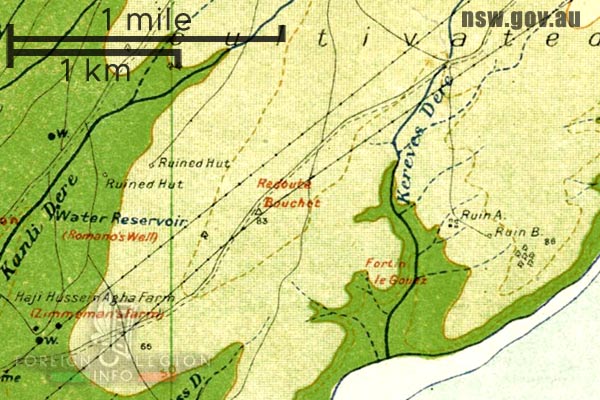
5th Attack of Kereves Dere (12-13 July 1915)
On July 12, the 1er RMA’s 1st Division was ordered to attack the Turkish positions at the lower part of Kereves Dere and then advance along the left bank. But during this action, the HQ of the 1st Division became under shelling. General Masnou was killed. The planned attack was then suspended.
However, in the evening, the attack was renewed. It would be led by freshly promoted Major Waddell of the Legion Battalion. At his disposal, there were two companies of legionnaires and two of zouaves. The Ottomans were vigorously defending their trenches. Nevertheless, after a terrible melee with bayonets and grenades, and thanks to the diligence of Major Waddell, the trenches would be occupied and completely cleared out of any enemies. Major Waddell, regardless of his through-and-through gunshot wound, asked to keep command to face expected counter-attacks.
Around midnight, such a violent counter-attack occurred, but it was successfully repulsed.
As of July 21, the heavily bloodied Legion Battalion would be reformed with a reinforcement of 5 officers and 255 legionnaires. Major Waddell, wounded, was replaced at the head of the Battalion by Captain Eugène Homo (then commander of the 10th Company). The machine gun platoon left the Battalion to be assigned to the regiment’s HQ.
In late July, a battalion of Hellenic volunteers (440 men) was attached to the 1er RMA, nicknamed as the Greek Legion. It was commanded by Major Pantelis Karasevdas, an Olympic champion in shooting at the 1896 Summer Olympics. For administrative reasons, this Greek battalion was assigned to the Foreign Legion.
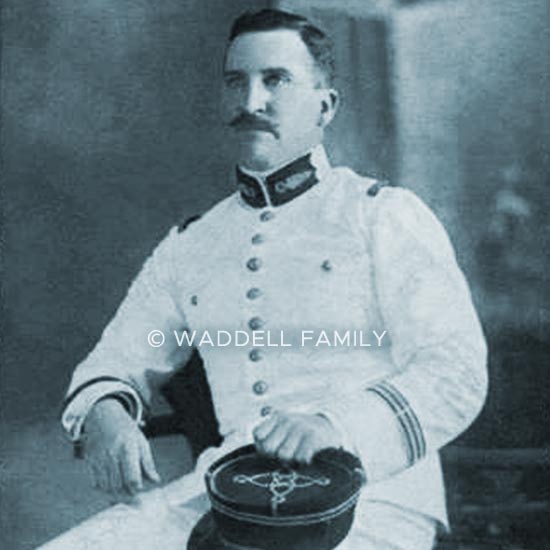
6th Attack of Kereves Dere (7 August 1915)
On the night of August 6, the British launched their final attempt (known as the Battle of Sari Bair) to seize control of the Gallipoli peninsula from the Ottoman Empire. The main operation started with a landing at Suvla Bay (northwestern part of the peninsula) in cooperation with the Australian and New Zealand Army Corps (ANZAC). In the south of the peninsula, the British also launched an action known later as the Battle of Krithia Vineyard. Meanwhile, the two French divisions conducted diversions on the front line with shelling, firing and partial attacks, in order to engage and keep as many Ottoman troops as possible in front of them to facilitate the landing operation and the British assault in the Suvla region. This time, the Legion Battalion was kept in reserve.
Unfortunately, although their landings at Suvla Bay didn’t see any opposition, the British did not take advantage of the situation. That was the last Allied joint operation on the Gallipoli peninsula.
On August 15, a reinforcement of 3 officers and 231 legionnaires arrived to the Battalion.
Two days later, Lieutenant Colonel Schneider took command of the 1er RMA.
In September, the Legion Battalion moved on the island of Tenedos to rest and refit for two weeks. The legionnaires regained the front line from September 20 to October 1.
On October 2, the 1er RMA left the Gallipoli peninsula, with the Legion Battalion, for Salonika in Greece. The expedition was over.
The military result of the Gallipoli campaign, which cost the lives of more than 50,000 British and French soldiers, is a subject of debate for historians. Ultimately the Allied attempt to seize the peninsula and to control the Dardanelles failed. One of the consequences of this unfortunate affair was the resignation of Winston Churchill, the future well-known British Prime Minister, from his post as First Lord of the Admiralty. He planned the campaign and was blamed for its failure. Nevertheless, the failure at Gallipoli had no impact on the following course of the First World War.
Foreign Legion Battalion officers killed on the Gallipoli peninsula
Captain Louis Devirieux
– killed on 12 July 1915
Captain Louis Rousseau
– seriously injured on 1 May 1915, he died on 7 May
Lieutenant Henri de Bonet d’Oléon
– killed on 11 May 1915
Lieutenant Jules Seilaz
– killed on 21 June 1915
Second Lieutenant Pierre Beck
– killed on 21 June 1915
Second Lieutenant Charles Caumer
– killed on 4 June 1915
Second Lieutenant Arcade Dufrene
– killed on 28 April 1915
Second Lieutenant Ferdinand Grégoire
– killed on 22 June 1915
Second Lieutenant Jean Taillantou
– killed on 22 June 1915
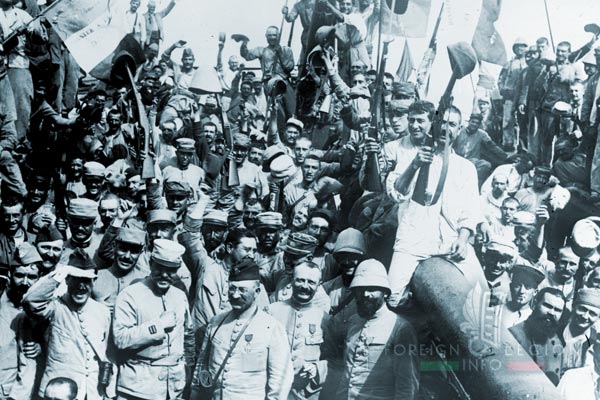
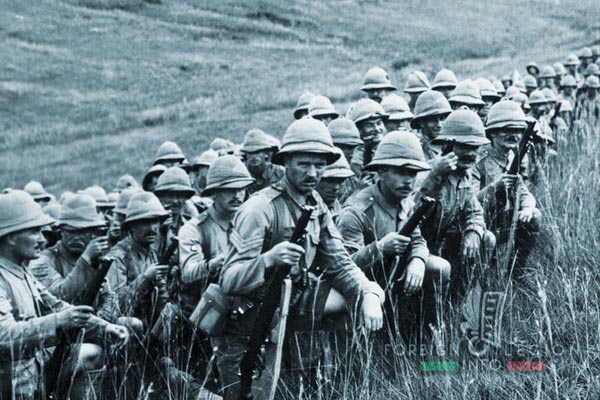
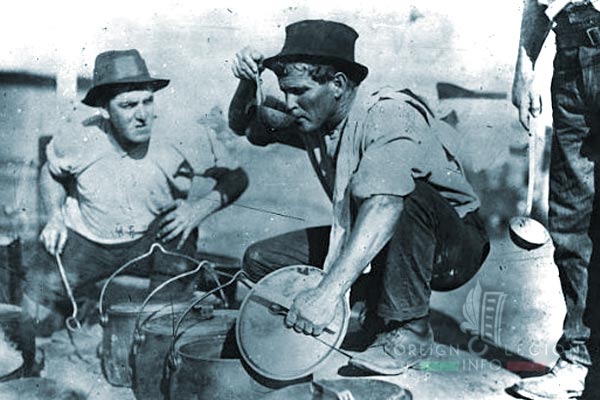
Macedonian front
The Macedonian front (also Salonika campaign or Salonica front) was a military campaign of the Allied Powers in the Balkans during the First World War. Carried out from the Greek port of Salonika (also Saloniki or Salonica; now Thessaloniki), the campaign was intended to support the Serbian Army (one of the Allied forces) by the British and French troops that had been evacuated from the Dardanelles since September 29, 1915.
Following the failure in the Dardanelles, the Allies were evacuating the Gallipoli peninsula from late September 1915 to early January 1916. Nevertheless, the French and the British decided to remain part of the evacuated troops in the region and send them as a small expedition force of two divisions (a French division and the 10th Irish Division) to help Serbia against the planned combined attack of the Central Powers, Germany and Austria-Hungary.
Since October 6, the 1er RMA, along with the 2e RMA, 175e RI and 176e RI of France’s Eastern Expeditionary Force, had been regrouped in Salonika in Greece (then a neutral country). These four regiments would form the 156th Infantry Division of General Bailloud and, simultaneously, the Army of the Orient (AO; in French, the term Orient could be used even for the Balkans), with General Sarrail as the commander-in-chief. In late October, the AO would be reinforced by the French 57th and 122nd Divisions which had landed in Salonika.
The four French regiments stayed two weeks at Camp Zeitenlik (2,5 miles / 4 km north of Salonika). Meanwhile, “SEDD-UL-BAHR 1915” and “KEREVES-DERE 1915” were inscribed on the flag of the 1er RMA.
At the same time, Major Jean replaced Captain Homo and took command of the Foreign Legion Battalion. The Battalion was composed of 18 officers (among them some Italians) and 528 non-commissioned officers and legionnaires. The Battalion’s 12th Company would serve as a Disciplinary Company, for the whole regiment.
Foreign Legion Battalion’s composition in October 1915
- Commander: Major Jean
- 9th Company: Captain Laurent
- Second Lieutenant Conte
- Second Lieutenant Denizon
- 10th Company: Captain Homo
- Lieutenant Césari
- Second Lieutenant Finelli
- 11th Company: Captain Chavanne
- Second Lieutenant Riccio
- Second Lieutenant Bringolf
- 12th Company: Captain Canudo (detached)
- Lieutenant Schmidt
- Second Lieutenant Casanova
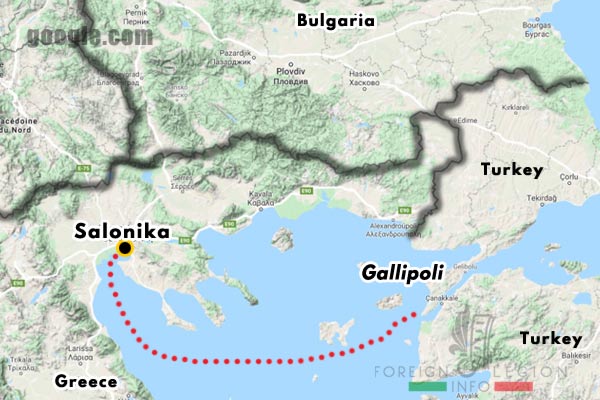
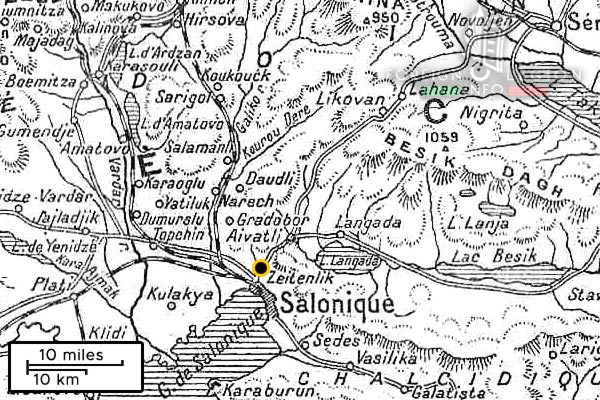

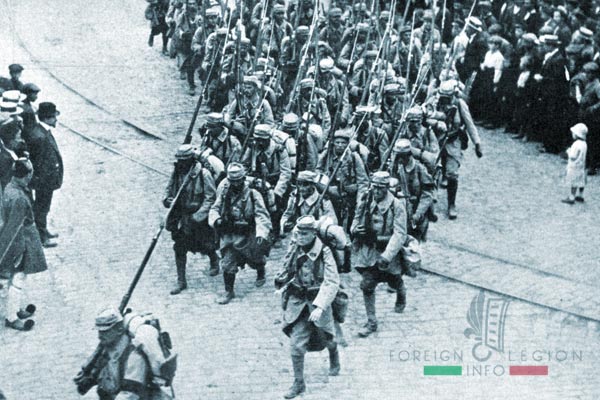
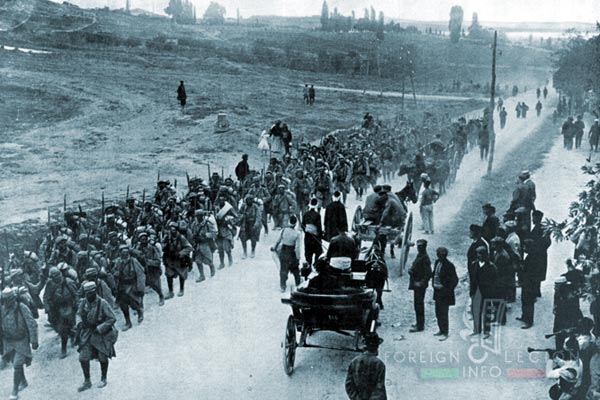
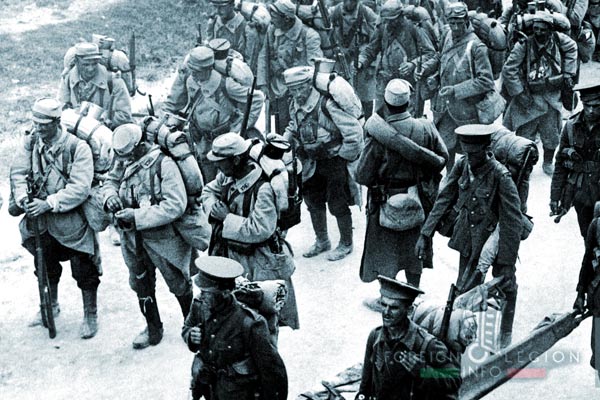
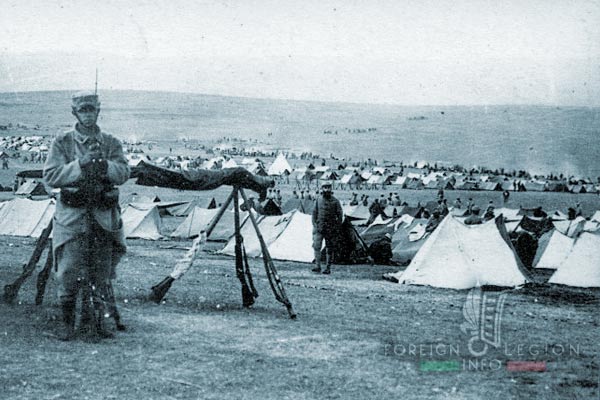
Serbian Campaign (1915)
In 1915, the Kingdom of Serbia was a good ally of France. King Peter I (Peter Karađorđević) did his military studies at Saint-Cyr, France’s most prestigious military academy. In 1870, he enlisted as a second lieutenant in the Foreign Legion to defend France against the Prussians and was wounded during the war.
In 1914, because of the assassination of Archduke François-Ferdinand, heir to the Austro-Hungarian throne, and his wife in Sarajevo on June 28, Serbia became one of the main protagonists of the First World War. In late July 1914, the Serbian campaign (1914) was launched by Austria-Hungary. However, after three unsuccessful Austro-Hungarian invasions of Serbia, the front stabilized in December 1914.
An almost year later, on October 6, 1915, the second offensive against Serbia was launched in the north by the Central Powers. The strategic goal of that offensive was to open up a direct land route from Germany through Austria-Hungary, then down to Bulgaria (their ally since early September) and as far as the Ottoman Empire. This would allow the Germans to send military supplies and even troops to aid the allied Ottoman Empire against the Franco-British effort in the Dardanelles and against Russia in the Caucasus.
Contrary to the failed 1914 campaign, the combined Austro-German armies were advancing rapidly to the south. On October 14, the Bulgarians declared war on Serbia and joined the offensive from the east. Their main goal was to attach Vardar Macedonia (today’s North Macedonia), seized by the Serbs in 1913, to Bulgaria.
The Serbian position became hopeless. To support their ally, the French and the British decided to leave Salonika and transfer their troops to Niš (a city of Serbia) to stop the Bulgarian progression and, at the same time, to retain control of the strategically important railroad Salonika-Niš (going up the valley of the Vardar River), the only supply route from abroad for the Serbs. The Allies also planned to make connection by this route with the retreating Serbian forces.
On October 18, 1915, the 1er RMA was transported by train to Gevgelija, then a main crossing point between Greece and Serbia (today, between Greece and North Macedonia). The soldiers continued to progress along the Vardar, up to the Stroumitsa-Station near Hudovo (Oudovo now). It’s a small village 12,5 miles (20 km) north of Gevgelija. The regiment arrived in Stroumitsa-Station in the evening.
The regiment’s HQ was set up at Hudovo while the Legion Battalion’s HQ was placed at Kaluckovo (1,5 miles / 2,5 km to the east, now Gorna Maala). The mission of the 1er RMA and the Legion Battalion was to protect the Salonika-Niš railroad in this sector (a large valley near the border with Bulgaria), along with two important points, a railroad bridge and the train station, against the rapidly advancing Bulgarians.
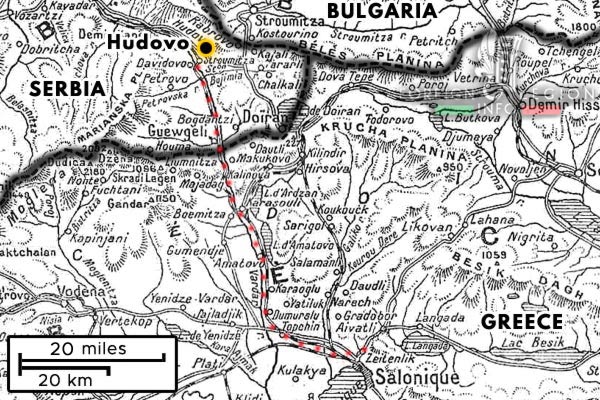
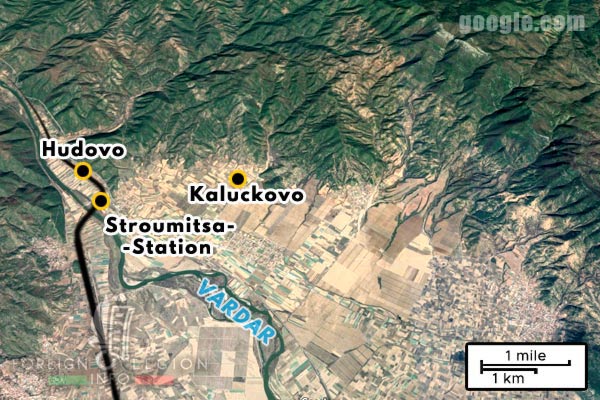



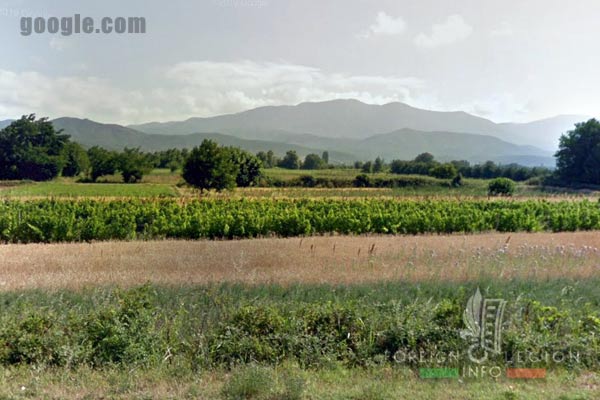
Little by little, the Bulgarians, along with their artillery, were trying to position themselves on the ridges around the valley to shell the bridge, the station and the French positions.
The first fighting between the legionnaires and the enemy occurred on October 22. That day, the Bulgarians attacked the French in the valley, from different locations. On Hill 328 near Terzeli, about 3 miles (5 km) east of the HQ of Kaluckovo, the 11th Company of Captain Chavanne vigorously defended their position all day. The defense was successful and the Bulgarians suspended further direct assaults. However, seven legionnaires were injured. Among the men who distinguished in the fighting with Bulgarians that day, is Second Lieutenant Hans Bringolf, a Swiss-Russian adventurer.
Four days later, Major Jean was assigned as the head of the 1st Battalion, 1er RMA to replace a commander killed during the fighting of 22 October. Captain Homo again took over the Legion Battalion. The Battalion would be reorganized a little, with an exchange of officers.
In the meantime, the legionnaires were conducting reconnaissance patrols on and outside the front line and were strengthening their positions.
As of November 3, a large reinforcement to the Battalion arrived, consisting of 3 officers and 298 men. Major Emmanuel Arqué replaced Captain Homo as the Battalion commander. He had served with the Legion since 1896; from June to October 1915, Major Arqué was the head of the 2nd Foreign Regiment in Algeria.
In the meantime, the 12th Company became a combat unit. An autonomous Disciplinary Platoon was constituted instead and assigned to the company. Even the Platoon served for the whole regiment, legionnaires and zouaves.
Between November 8 and 12, the legionnaires of Lieutenant Schmidt‘s 9th Company seized two hills that had been held by the Bulgarians north-east of Ayranli, about 3,5 miles (5,5 km) east of the Battalion’s HQ at Kaluckovo. On November 14, one more hill would be seized by these legionnaires. But two of them were killed, five legionnaires were wounded.
Two days later, on November 16, the regiment was ordered to capture an isolated hill occupied by Bulgarians, situated near Ayranli. The legionnaires were charged to carry out the operation. The hill (mamelon) was called “Two Trees Hill” (Des deux arbres; in historical works, the hill is incorrectly called Isolated Massif or Dent de Scie). The 10th Company of Captain Homo, supported by a platoon of Captain Colin‘s 12th Company, climbed the steep slopes of Two Trees Hill, while the 9th and 11th Companies attacked the hill from the Dent de Scie (Sawtooth), another hill, situated near Veseli.
But the legionnaires couldn’t reach the highest peaks, where the Bulgarians were strongly entrenched. The fighting was tenacious and the losses of the Legion Battalion were significant. During the operation of November 16, Captain Eugène Homo and 18 legionnaires were killed, Second Lieutenant Riccio and 45 legionnaires were wounded. Second Lieutenant Volokhoff, until now having served as a translator with both the battalion’s and regiment’s HQs, took command of the 10th Company. An officer of Russian origin who enlisted in November 1914, he would made a great career under the French flag, in the Legion as well as in the Air Force.
The next day, November 17, the Bulgarians attempted to seize the positions of the 9th and 11th Companies on the ridges north of the Sawtooth Hill. After six hours of fighting, the enemy was repulsed, decimated by grenades. About 250 Bulgarians were killed. But there were also 13 legionnaires killed and 50 wounded.
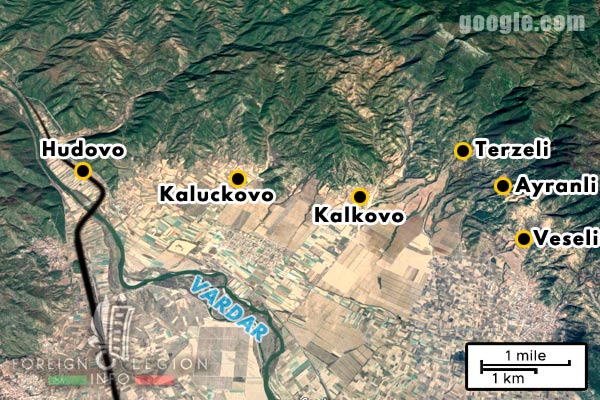



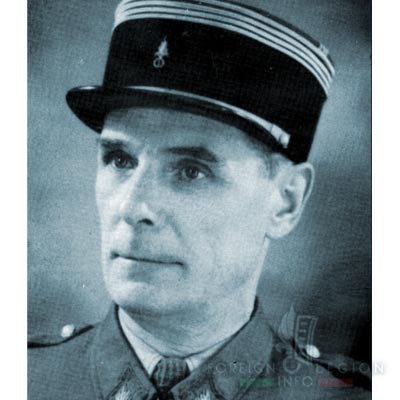
Since November 18, the shelling had hardly ceased, but there wouldn’t be any serious action due to a rapid fall of temperature to 5 °F (-15 °C). However, the reconnaissance patrols continued on the front line.
Two days later, another large reinforcement to the Battalion arrived, consisting of 322 NCOs and legionnaires under the command of Captain Albert Azan (head of the 1st Foreign Regiment in 1935-39).
On November 25, the greatly outnumbered Serbian Army, under the pressure of the Austro-Hungarians, the Germans, and the Bulgarians, was ordered to retreat in a southwesterly direction, through Albania, toward the Adriatic Sea. The Serbians would be evacuated by the Allied fleet to be reorganized in Greece and to continue the war alongside the Allies.
In the face of the Serbian Great Retreat, the Franco-British forces were ordered to withdraw to Greece, by train or on foot, along the Vardar. The 1er RMA was therefore ordered to cover the Franco-British withdrawal and to hold their positions as long as possible.
The sector assigned to the regiment became even more active. Gunfire and shelling on the front line were frequent and injured the legionnaires.
On December 3, five legionnaires were killed in a Bulgarian attack. But the most bloody action took place during the night of December 7-8. It was a series of violent assaults aimed at the positions north of Sawtooth Hill (Dent de Scie), held at all costs by the 9th and 11th Companies. That night, 12 legionnaires were killed; Second Lieutenant Blanchard and 61 legionnaires were wounded. But the Bulgarians were fought off.
On the night of December 8, there were another seven enemy attacks aimed at these positions, well repulsed by bayonet charges, while the men were singing the “Marseillaise” and the “Chant du départ” (“Song of the Departure”). Nine legionnaires are wounded.
Nevertheless, in the meantime, with all Franco-British troops successfully withdrawn from Serbia to Greece, even the 1er RMA would start their retreat to Salonika. In the early morning of December 9, all positions, well defended during the previous six weeks, were abandoned. The men had to march along the Vardar, to the south. The Legion Battalion was designated as the rearguard of the regiment and, thus, as the rearguard of all allied divisions.
On December 11, near Cernica (Grchishte), the 10th and 11th Companies were heavily shelled by enemy artillery. In this attack, the Battalion suffered 5 legionnaires killed; 27 legionnaires were wounded.
Through Gavato, the Legion Battalion moved on December 12 to Bogoroditsa, a village on the border with Greece, and crossed the border as the last allied unit. A week later, on December 18, the legionnaires arrived by train at the camp of Vatiluk (Vathylakkos now), north-west of Salonika. The Serbian Campaign was over.
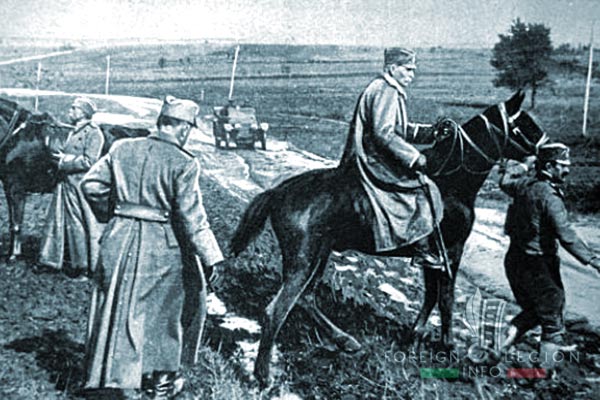
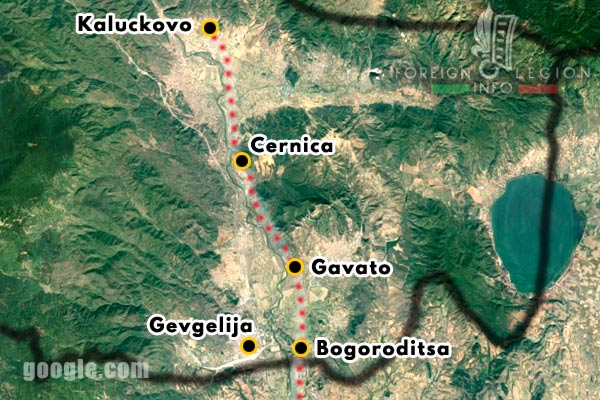
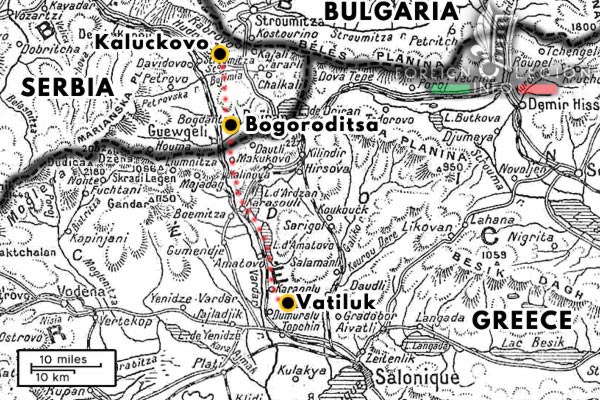
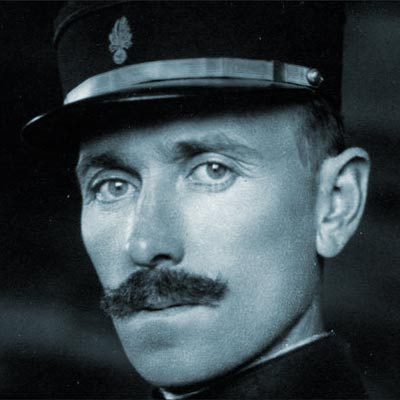
Salonika front: December 1915 – August 1916
The Legion Battalion remained at Camp Vatiluk until March 1916. During this period, the legionnaires were responsible for reinforcing and consolidating the second line positions north of Vatiluk, where they alternated with the 175th Infantry Regiment. The legionnaires returned to the camp to carry out training for subsequent operations. At the end of December, 3 officers and 91 men arrived to reinforce the Legion Battalion.
Among them, Lieutenant Bjerring, a Danish officer assigned to the 10th Company. Having taken command of the company and been promoted to Captain since late April, he left the Battalion in early May for the 17th Colonial Division.
On December 31, Major Arqué was promoted to Lieutenant Colonel and assumed command of the 175e RI. A week later, Major Geay, wounded on the Gallipoli and detached after his recovery to the 175e RI, replaced him at the head of the Legion Battalion.
In February, the Battalion was reinforced with more than 200 legionnaires and its strength totaled 981 men.
As of 18 March 1916, the 1er RMA and the 175e RI left Camp Vatiluk and moved toward the Greco-Serbian border (together, these units formed the 311th Brigade of Colonel Fillonneau, within the 156th Division). Their goal was to improve the roads and tracks situated to the east and north-east of Lakes Ardzan and Amatovo, in the sectors of Avret Hisar (today Ginekokastro), Kirec (Chorigi), Gavalanci (Valtoudi) and Kalinova (Soultogianneika). They also were to build fortifications and conduct patrols along the line of contact with the enemy. They faced the Bulgarians that held their positions south of Lake Doiran, east of Bogoroditsa.
Foreign Legion Battalion’s composition in late April 1916
- Commander: Major Geay
- HQ Staff: Captain Azan
- 9th Company: Captain Hamot
- Second Lieutenant Denizon
- Second Lieutenant Conte
- Second Lieutenant Volokhoff
- 10th Company: Captain Bjerring
- Second Lieutenant Finelli
- Second Lieutenant Noleau
- 11th Company: Captain Chavanne
- Second Lieutenant Bringolf
- Second Lieutenant Lemaire
- Second Lieutenant Rosini
- 12th Company: Captain Bruera
- Lieutenant Césari
- Second Lieutenant Casanova
- Second Lieutenant Wimmer
- Second Lieutenant Rubin
- Disciplinary Platoon: Second Lieutenant Saint Pierre
In May 1916, the Serbian Army was reconstituted in Corfu and transported to Greece. The Serbs were sent by General Sarrail to the west, to Florina (a city of West Macedonia, in the north of Greece), to prevent the invasion of the German-Bulgarian troops.
In June, the Allies declared a state of siege in Salonika. Greek Prime Minister Zaïmis ordered the demobilization of the Greek Army following disagreements with the Allies.
On July 31, the 156th Division was replaced on the front line by the British. The 1er RMA, including the Legion Battalion comprising 763 NCOs and legionnaires, withdrew from the area and moved to the sectors of Bohemica (Axioupoli) and Celtik (Rizia), situated west of Lake Amatovo and the Vardar River. The units of the 156th Division, now commanded by General Baston, were camping there until August 21.
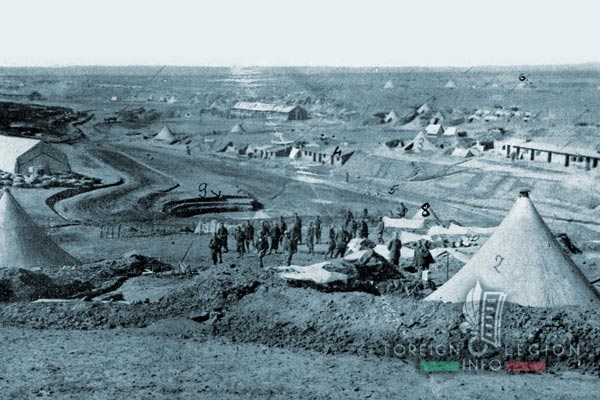
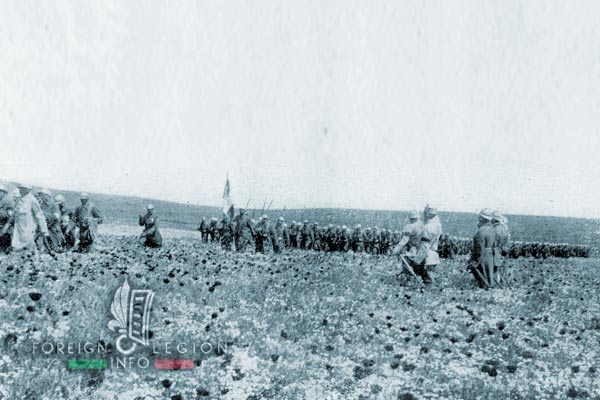
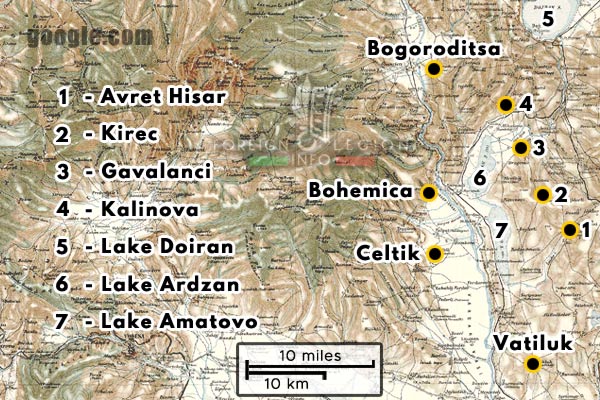
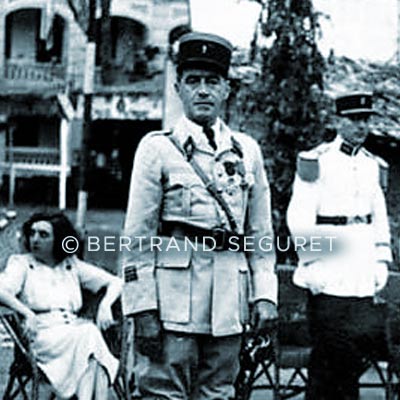
Offensive on Florina and Monastir (1916)
On August 11, the Army of the Orient became the French Army of the Orient (AFO), led by General Cordonnier. The AFO became part of the newly formed Allied Army of the Orient (AAO), commanded by General Sarrail. In addition to the French (80,000 men), the AAO also included the troops from the British army (80,000 men), the Serbian army (100,000 men), as well as Russian, Italian and Greek detachments.
On August 17, the Bulgarians launched an operation and managed to occupy a large part of the north of Greece to the northeast of Salonika. They also seized the city of Florina in the west.
The Allies took the initiative. At the end of August 1916, the French, the Serbs and the Russians were deployed toward Lake Ostrovo (Vegoritida), to start an offensive on Florina and then to the north, on Monastir (Bitola) in Serbia.
The 156th Division left Celtik and Bohemica on August 21, to be transported by train to the west, to the Lake Ostrovo, via Salonika and Vertekop (Skydra), where it arrived the next day. On August 25, the Legion Battalion had to march through the mountains toward Udzana (Komnina), to cover the front lines of the Serbs who had already been established in the region. As of August 31, the Battalion arrived in Udzana to camp there.
On September 2, the 1er RMA was reorganized. The battalions’ fourth companies were inactivated and replaced by the Machine Gun and Infantry Gun Companies (CMC), equipped with St. Étienne Mle 1907 machine guns and 37 mm infantry guns. The 12th Company of the Legion Battalion was therefore dissolved. It was replaced by the 3e CMC, consisting of non-Legion elements. The legionnaires of the former 12e Cie completed the three remaining Legion companies, which now number 4 officers and 200 men each. The Disciplinary Platoon was attached to the 11th Company.
Foreign Legion Battalion’s composition in September 1916
- Commander: Major Geay
- HQ Staff: Captain Azan
- 9th Company: Captain Hamot
- Lieutenant Conte
- Second Lieutenant Denizon
- Second Lieutenant Rubin
- 10th Company: Captain Canalés
- Lieutenant Finelli
- Second Lieutenant Noleau
- Second Lieutenant Heineman
- 11th Company: Captain Césari
- Second Lieutenant Casanova
- Second Lieutenant Lemaire
- Second Lieutenant Rosini
- Disciplinary Platoon: Second Lieutenant Saint Pierre
- 3e CMC (non-Legion): Lieutenant Bévéraggi
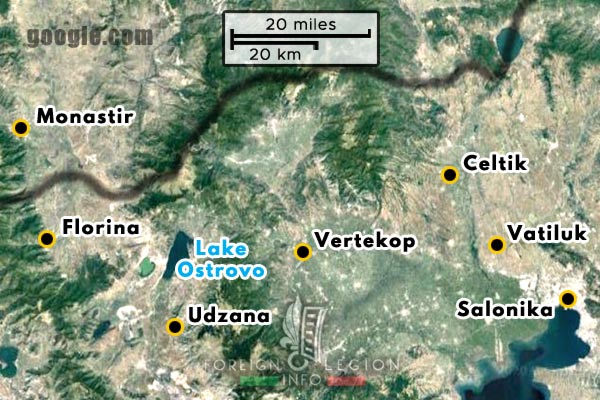
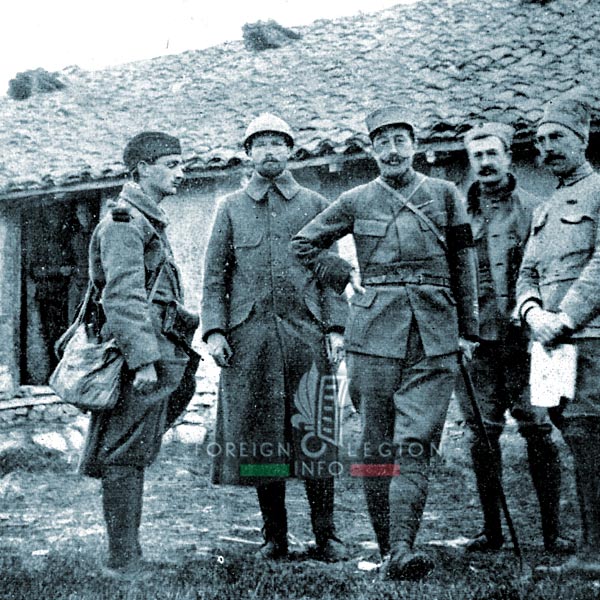
Battle of Florina
On September 9, the Legion Battalion advanced by Konop (Drosero) and Cor (Galateia) on Rakita (Olympiada). All three villages would be occupied. In the evening and the next day, two Bulgarian attacks occurred in Rakita. The enemy was repulsed. However, 8 legionnaires were killed and 16 were wounded.
On September 12, General Sarrail resumed the offensive on Florina. The Legion Battalion moved to the north-west, via Novoselo, Gjulunc (Radonas) and Spanca (Fanos). At Spanca on September 14, legionnaires in teams of 3-4 men successfully passed through a tight barrage of artillery shelling and attacked the enemy trenches. The trenches were brilliantly overrun in the presence of General Cordonnier of the French Army of the Orient. He congratulated the legionnaires for their excellent behaviour during this action. That day, the villages of Spanca and neighbouring Eksisu (Xino Nero) were captured. The Battalion suffered 7 men killed, and 23 men wounded.
Thereafter, the legionnaires advanced towards Florina, through Leskovec (Leptokaries), Pesosnica (Ammochori) and Boresnica (Palaistra), where they relieved the Serbs on September 21. Four other men among them were killed.
On September 24, the Legion Battalion was ordered to launch a frontal assault on the Bulgarian positions in Petorak (Tripotamos), located north-east of Florina. The Battalion courageously attacked, under heavy fire from shells, bullets and machine guns. But the men couldn’t move forward: the barbed wire entanglements and the trenches were intact by the French artillery, which had been shelling the Bulgarians for half an hour before the Legion’s assault. To avoid unnecessary losses, the attack would be eventually suspended. Nevertheless, 15 legionnaires had been killed during the assault; Second Lieutenant Finelli and 46 legionnaires were wounded.
The next two days, the Battalion positions near Petorak were shelled. The artillery fire killed 11 legionnaires; Captain Azan and 17 men were injured.
On September 29, a reinforcement of 51 men arrived to the Battalion.
The same day, in Salonika, a pro-Allied provisional Greek government of Elefthérios Venizélos was formed, supported by France. This affair caused the direct conflict between King Constantine I (who remains neutral) and the provisional government around Venizelos, and created the National Schism.
Between 30 September and 3 October, the relieved Battalion camped in Boresnica.
As of October 2, the situation changed. The Bulgarians, pressed by the Allied troops, abandoned their positions at Florina and withdrew to the north, toward Monastir in Serbia.
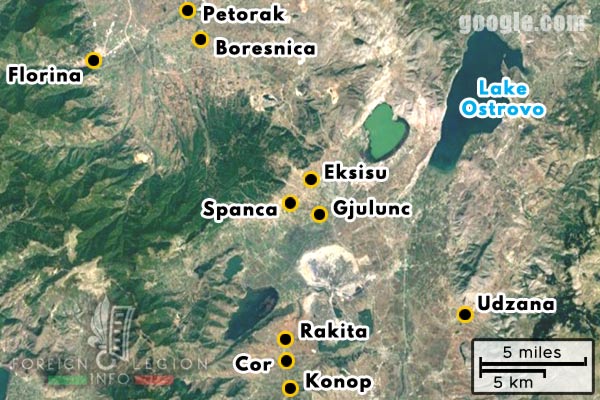


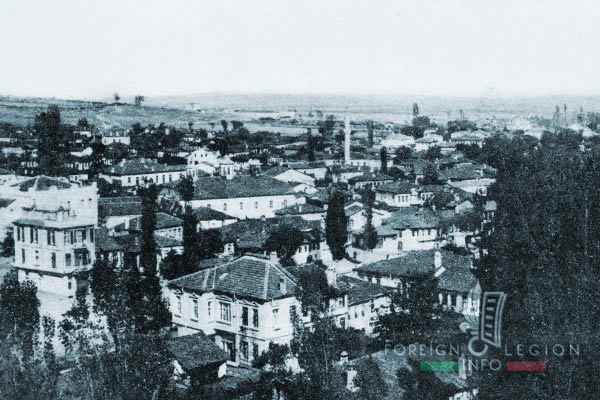
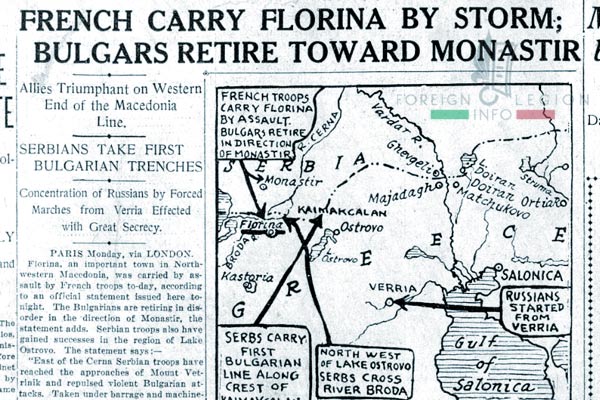
Battle of Monastir
On October 3, the Bulgarian withdrawal was followed by an Allied offensive. The Legion Battalion moved through Kalenik (Kalliniki) to Negocani (Niki), a village occupied by the Bulgarians, located at the Greek-Serbian border. The next day, Negocani would be overrun. Thereafter, the 1er RMA, along with a Russian Brigade to the left and the 2e RMA to the right, launched an attack against the Bulgarian defense line of Medzidli (Medzhitlija) – Kenali (Kremenica), villages situated some 2 miles (3 km) to the north-east, already in Serbia. However, the attack failed and the 1er RMA remained at Negocani.
For two days, enemy artillery shelled the Battalion’s positions. A legionnaire was killed, 18 men were wounded.
October 6, a new attack was carried out by the Russian Brigade, 1er RMA and the 2e RMA against the Bulgarian trenches of Kenali. But the well entrenched Bulgarians repulsed once again the allied assault. During that eight-hour fighting, Second Lieutenant Léo Denizon and 9 legionnaires were killed; Captain Canalés, Lieutenant Noleau and 44 legionnaires were wounded.
After this failure, the front stabilized. An attack carried out a week later by the French colonial troops failed too. The calm situation remained unchanged until 15 November. However, due to the systematic shelling of the superior Bulgarian artillery, there were 6 legionnaires killed and 32 wounded during that period. In late October, a detachment of 138 legionnaires, led by Lieutenant Pla, arrived to reinforce the Battalion. In the meantime, General Leblois took over the AFO.
On November 3, Major Henri Rivet replaced Major Geay, detached outside the regiment. Major Rivet, an old chasseur à pied, he had served with the 2e RMA before taking over a French-organized short-lived Bosnian Battalion, dissolved in September 1916.
Although the front that had been attacked by the Franco-Russian troops near Kenali could not be pierced, the Serbs on the left managed to advance to the north, towards the Crna River in the Serbian territory. As of November 15, the Bulgarians abandoned their trenches and retreated toward Monastir. The Franco-Russian forces, including the Legion Battalion, would pursue them through Medzidli, Zabjani (Zhabeni) and Bistrica.
On November 19, the Allies finally reached Monastir, an important city and an administrative center of the region. Numerous fires predicted a new withdrawal of the enemy. A reconnaissance in the city is therefore organized by a platoon of the 9th Company, Legion Battalion. Commanded by Captain Hamot, this platoon was one of the very first unit of the Allied troops to enter the city. They even surprised the Bulgarian rearguard and, with the help of the Serbian cavalry and the elements of the 57th Division, the enemy was driven out. Monastir was captured.



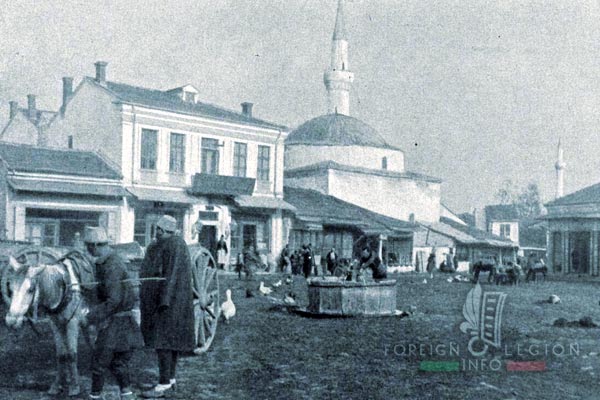


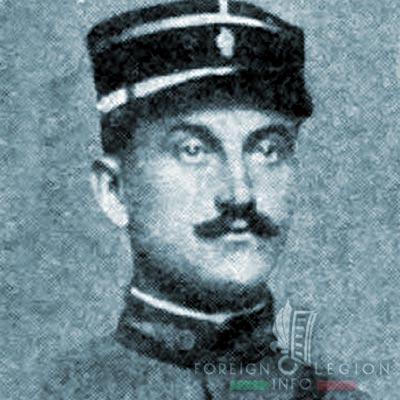
Monastir Front: November 1916 – March 1917
Gorno Orizari and Dolno Orizari
In late November 1916, the Allied forces captured Monastir. The Bulgarians withdrew towards the north-east and especially towards the mountains west and north-west of the city. They entrenched there solidly with their artillery batteries and, since the end of November 1916, Monastir had been subjected to daily shelling.
The 1er RMA was stationed to the north-east of the city, in front of the first line of enemy trenches. The Legion Battalion set up their strongholds in Gorno Orizari and Dolno Orizari. The men started the construction of defensive positions, despite ongoing bombardments. Exchanges of fire during patrols and reconnaissances beyond the boundaries of the assigned sector were also frequent. The legionnaires would be relieved every four days to take rest south of both Orizari, in Pozdes (Poeshevo today), a fortified village surrounded with barbed wire. It served as the HQ of the 311th Brigade. In late December, the fortifications were finished, with barbed wire entanglements placed up to 5 meters in width. During these six weeks, the battalion’s losses were 7 legionnaires killed and 40 wounded.
In December, two reinforcements arrived to strengthen the Battalion. They numbered an officer (Captain Jumancourt) and 214 men. Captain Hamot, adjutant-major (the deputy commander), was evacuated. As a lieutenant, he made already part of the original Battalion in March 1915.
Meanwhile, on December 2, after severe clashes with the Greeks, General Sarrail‘s troops occupied Athens. The goal was to stop the ambiguous attitude of the king and the official government. The Greek crisis was resolved only in June 1917, with the king’s abdication and the installation in Athens of the parallel government of Venizelos, favorable to the Allies (which had remained in Salonika until June 1917).
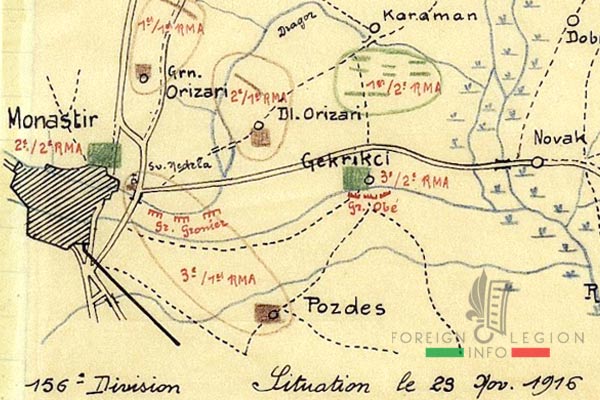

Baba massif and the Crvena Stena
On 2 January 1917, the 156th Division left the Sector East to relieve an Italian brigade in the Sector West of Monastir, situated between the Baba massif (also Baba, Baba Mountain or Baba Planina) and the Monastir-Resne (Resen) road. The 1er RMA units were stationed at Lahce (Lavci), Brusnik and also at Nizopole (Nižepole), a position on the front line, always relieved. The 156th Division’s HQ was stationed at Bukovo; those of the 311th Brigade and the 1st RMA were at Lahce.
The Legion Battalion set up their camp in the Lahce ravine. It was necessary to organize the bivouac and to rebuild Italian positions, insufficient for protection. Thereafter, to allow an easier supplying in this mountainous region, the legionnaires had to improve existing ways of communication and start construction of the new ones.
The mission of the 1er RMA and the Battalion was purely defensive. The units had to hold on to their positions at all costs.
Bulgarian troops, supported by German officers and soldiers, were entrenched in the Baba massif, on the Crvena Stena ridge (Red Wall; wrongly mentioned as Trana Stena in most sources), as well as around the villages of Trnovo and Magarevo, west of Lahce. The enemy infantry showed little activity at the time and limited their actions to repelling French patrols. On the contrary, the Bulgarian artillery systematically shelled the roads, the camps and the French defensive positions in the sector.
Since January 20, an abundance of snow had fallen almost every day. It would cover the entire region, until March. In the mountains, the temperature oscillated between -15 and -22 °F (-25 and -30 °C).
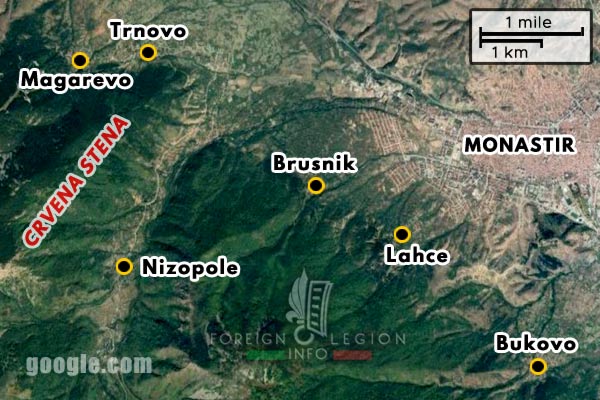
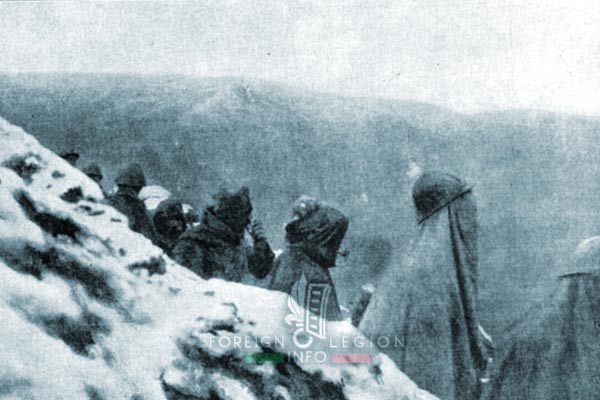
On January 21, Captain Grabot (outside the Legion) was assigned to the Battalion as a new adjutant-major. Three days later, Captain Césari (11th Company) was evacuated. He would be replaced by an officer of Italian origin, Captain Pignatelli di Cerchiara, who came from the Western Front in France.
On February 7, the Legion Battalion moved from Lahce to Brusnik. On February 13, after a few weeks of work, a Bukovo-Nizopole supply track (going through the mountains) was completed by the Disciplinary Platoon. The same month, the CMC machine gun companies became CM. Teams of 37 mm infantry guns formed a separate Infantry Gun Platoon within the regiment.
On March 7, a battalion of Albanian volunteers, commanded by Lt Colonel Geay (the former head of the Legion Battalion), was administratively attached to the 1er RMA and stationed at Lahce.
Foreign Legion Battalion’s composition in mid-March 1917
- Commander: Major Rivet
- HQ Staff: Captain Grabot
- 9th Company: Captain Masson
- Second Lieutenant Genet
- Second Lieutenant Breney
- 10th Company: Captain Jumancourt
- Second Lieutenant Bertini
- Second Lieutenant Tisné
- Second Lieutenant Taillemite
- Second Lieutenant Rosini
- 11th Company: Captain Pignatelli di Cerchiara
- Second Lieutenant Casanova
- Lieutenant Sac
- Disciplinary Platoon: N/A
- 3e CM (non-Legion): Lieutenant Bévéraggi
Battle of Monastir (1917)
In March, the forces of the Entente sought to take back the initiative. For the spring of 1917, General Sarrail planned a large offensive against the German-Bulgarian troops, at the bend of the Crna River and near Lake Doiran. He also planned an attack north and west of Monastir. The city was still under enemy shelling and a moment of calm for the local civilians as well as for the Allied troops was needed.
On the Monastir Front, Sarrail‘s plan was to drive away or neutralize the Bulgarian artillery, by attacking Crvena Stena and the Baba massif, as well as Hill 1248 situated north-west of the city.
Battle of Crvena Stena (March 14 – May 16, 1917)
Since early March, a final improvement of defenses had started. The units of the 1er RMA were organizing their positions mainly on the front line at Nizopole and at the forward French stronghold on Crvena Stena, known as Fort National. This stronghold was situated right opposite the Bulgarian trenches called Posen. From March 8 to 14, all companies of the Legion Battalion were building spots for French batteries in the sector of the regiment. Among other things, the legionnaires helped haul manually artillery pieces up to the Col de Déjeûner, at about 4,900 ft (1,500 m) above sea level.
On March 14, the battle began. The next morning, elements of the 175th Regiment managed to capture part of the Posen trenches. In the evening, they were relieved by the 1er RMA’s 1st Battalion. On the night of March 17-18, the Legion Battalion that had been held in reserve at Dihovo (a village nearby Fort National) was ordered to relieve the 1st Battalion on the front line. The 10th and 11th Companies + PD + two 3e CM platoons were placed at Posen; 9th Company and a 3e CM platoon were to occupy Fort National. Both of these positions were under an immense Bulgarian shelling. In the afternoon of March 19, the legionnaires carried out a successful attack and managed to gain about 150 yards (140 m) of the ground in the western part of the Posen trenches, in direction of Trnovo. On March 20, the Battalion would be relieved by zouaves and returned to Dihovo. During the two nights on the front line, 9 legionnaires were killed; Second Lieutenant Tisné and 28 legionnaires were injured.
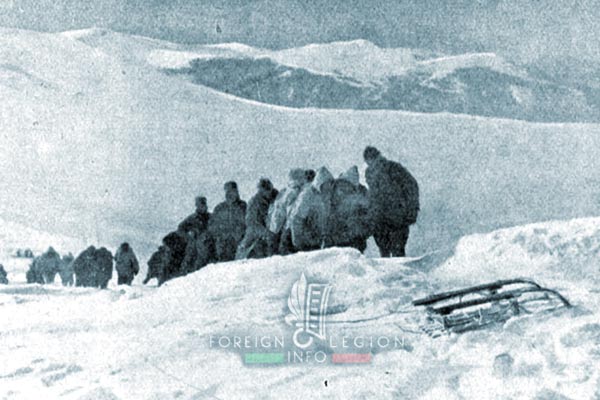
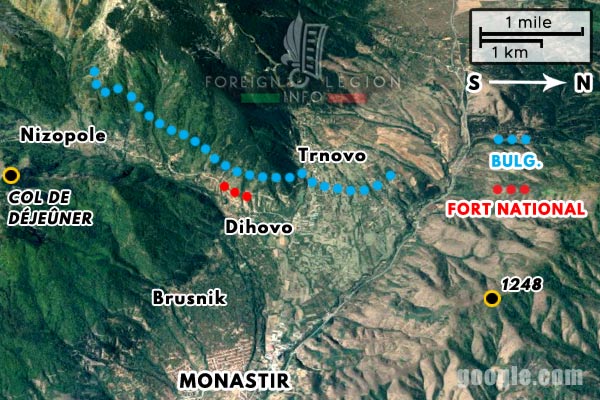

On March 24, for health reasons, Lt Colonel Schneider left the command of the 1er RMA. He would be replaced by Lieutenant Colonel Geay who would also be keeping the command of the Albanians.
The same day in the evening, the Legion Battalion returned on the front line. After the relief, a platoon of the 9th Company stationed at Posen was hit by an enemy shell. Sergeant Faubourg was killed, 13 legionnaires were wounded. Also that day in the evening, Adjudant J.L. Ramaeckers, a Dutchman with almost 15 years of service with the Legion, was killed at Posen during an enemy attack. He had been detached to the 1st Machine Gun Company, 1st Battalion at the time.
The 26th of March marked a retaliation of the legionnaires for that loss. They conducted one of the most beautiful actions of the 156th Division in Monastir. In the afternoon, supported by the 11th Company and a 155 mm battery, the 10th Company of Captain Jumancourt launched a daring assault and progressed from Posen to the east, towards the enemy trenches called Munich, while having gained about 875 yards (800 m) of the ground. In addition, 5 officers and 166 soldiers, astounded by that assault, were captured by the legionnaires without fighting; 3 machine guns, 6 bomb-throwing catapults and other war materiel were also captured.
That day, the Battalion had lost Captain André Pignatelli di Cerchiara and 3 legionnaires, all of them killed; Second Lieutenant Rosini and 14 legionnaires were injured.
On March 27 and 28, the Bulgarians launched five violent counter-attacks to regain the positions they had lost, but without success. The Legion held tenaciously. Nevertheless, the enemy artillery would continue in shelling the front line with great intensity. During these two days, 9 legionnaires were killed and 62 injured.
Among the injured, Adjudant Henri Naumann, a Warrant Officer of the 10th Company. A long-serving legionnaire, he had been injured and lost an eye when repulsing a Bulgarian counter-attack on March 28. Adjudant Naumann, already decorated with the Military Medal in 1916, he would become the very first non-commissioned officer of the French Army of the Orient (and of the Foreign Legion in 1914-18) to be awarded with the Legion of Honour, the highest French decoration.
On the night of March 28, the legionnaires on the front line were relieved. Thanks to their successful actions and bravery between March 26 and 28, 1917, the Legion Battalion would be mentioned in dispatches at the Army level, for the second time.
The situation had calmed down a bit, until April 12. Since that day, the shelling of the French positions continued night and day. On April 17, the immense bombardment increased up to 500 rounds per hour. At 6 p.m. (18.00) at Posen, the German-Bulgarian troops, preceded by flamethrowers, launched a heavy assault. The zouaves of the 2nd Battalion couldn’t resist the adversary and were eventually overrun. The whole Posen fortification was lost. But not for long. Two days later, on April 19, a battalion of the 2e RMA and a battalion of the 1er RMA, supported by the 10th and 11th Companies of the Legion Battalion, carried out a counter-attack. The French succeed and took their lost trenches back. The enemy on the run had abandoned 62 prisoners and a number of wounded.
Since April 20, the front had stabilized and the mission of the 156th Division became purely defensive again. With the exception of May 16. This day was marked by an attack carried out by the zouaves to distract attention of the enemy from the offensive at the Crna Bend.
The series of operations known as the Battle of Crvena Stena, which made part of the Battle of Monastir of 1917, was over. Monastir was somewhat cleared, but the city remained under enemy fire until September 1918, half destroyed by more than 20,000 shells. About 500 residents would be killed.
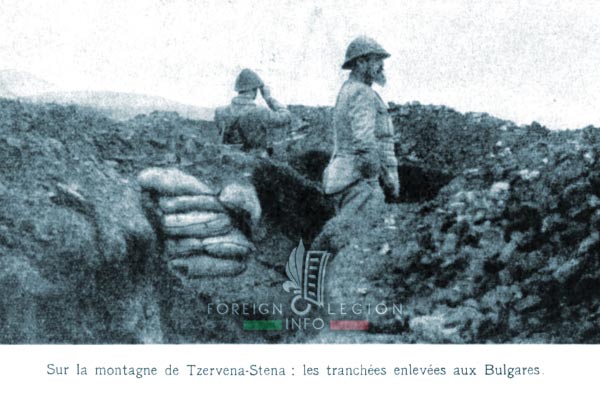
Monastir Front: May – August 1917
The Bulgarian shelling remained intensive, but the offensive actions on the front line had ceased and were replaced by the static trench warfare, so characteristic for the whole Great War. Until July 1917, the Legion Battalion units alternated between Posen, Fort National, Dihovo and Brusnik. In June, Major Rivet moved with his HQ to Nizopole, followed by part of the Battalion. The second part remained at Dihovo with Captain Grabot who would command the fortifications of Posen and Fort National. On May 31, an important reinforcement arrived to refresh the Battalion, led by Captain Harburger. This elderly, bearded officer from France’s Alsace started his career as a simple legionnaire. Lieutenant with the Battalion already in March 1915, he would rejoin at the regimental HQ his former superior, Lt Colonel Geay, and remain with him until the end of the war.
On June 29, after the Greek king’s resignation and exile, and after the installation of the Venizelos government in Athens, Greece entered the war alongside the Allies.
July 9 marked a Bulgarian attack on the Legion positions at Posen. During the attack, 5 legionnaires were killed and 12 wounded. There were also injuries among the men of 3e CM. One of them, Second Lieutenant Baudez, had his right arm amputated.
Two weeks later, Lt Colonel Geay left for leave. Major Rivet replaced him at the head of the regiment. In the meantime, Captain Jacques Grabot took command of the Battalion.
At the end of July, the mission of the 156th Division in Monastir was accomplished. It would be relieved in its sector by the 30th Division (two French regiments + two Russian regiments + a Greek regiment) and sent back to Greece.
Camp Gradobor
The Legion Battalion left the Sector West on August 6, as the last unit of the division. The men would march all the way to Petrsko (Petres), a village in the region of Banica (Vevi, situated east of Florina), where the 1er RMA had to be gathered. When passing through Negocani, the legionnaires paid tribute to their comrades who were killed and buried there in October 1916. The Battalion reached Petrsko on August 11 and took their rest nearby.
On August 20 and 21, the regiment was at Eksisu. The soldiers boarded a train that took them to the east. Thereafter, they moved by foot to Gradobor (Pentalofos, northeast of Salonika), where the regiment arrived on August 22. At Gradobor, the 1er RMA ceased to be part of the 156th Division. It would be in direct disposition of General Sarrail instead.
As soon as the men set up their tents, they were employed with arrangement of their camp and with instruction. They did exercises and marches, practiced shooting and throwing grenades.
On September 13, Lt Colonel Geay returned from leave; Major Rivet took over the command of the Battalion again.
On September 21, General Sarrail decided that the Legion Battalion was allowed to obtain the fourragère for their two mentions at the Army level.
Two days later, another decision occurred. The Legion Battalion, which went relentlessly through the operations at Gallipoli and on the Salonika front, was to be dissolved. With the exception of the 11th Company, the Disciplinary Platoon and the 3e CM composed exclusively of zouaves. At the same time, the 2e RMA was also to be disbanded; its men would constitute the new 3rd Battalion of the 1er RMA.
The Foreign Legion Battalion ceased to exist on September 30, 1917.

Foreign Legion Company in Southeastern Europe
On October 1, 1917, the Foreign Legion Company was constituted in the Balkans, at Camp Gradobor. It comprised three combat platoons and the Disciplinary Platoon, with the strength of 5 officers, 32 non-commissioned officers and 318 legionnaires (350 men in total). Among the officers, Second Lieutenant Léon, hero of the Legion at Gallipoli in 1915. Captain Charles Conte, second lieutenant with the Legion Battalion in Serbia in late 1915, took command.
The Compagnie de Légion remained at the camp and continued in carrying out its work and training. Three weeks later, the men were reinforced by Second Lieutenant Bedel. The unit would be rebuilt to four combat platoons and the PD.
Foreign Legion Company in October 1917
- Commander: Captain Conte
- 1st Platoon: Lieutenant Zanchetta
- 2nd Platoon: Second Lieutenant Noleau
- 3rd Platoon: Second Lieutenant Léon
- 4th Platoon: Second Lieutenant Bedel
- Disciplinary Platoon: Second Lieutenant Lemaire
On October 30, 1917, the Fourragère was handed over to the Legion Company. Lieutenant Colonel Geay personally awarded Captain Conte with that distinction. Then the 1er RMA battalions were parading in front of the legionnaires who guarded the regimental color.
The next day, by note from Sarrail, the 1er RMA and the Company were assigned to the 122nd Division of General Castaing. The units left the camp and went to relieve the 78th Brigade of the 26th British Division of General Colin in the subsector north of Karasouli (now Polykastro), a village located 40 km from Gradobor, between Bohemica and Lake Ardzan. The men arrived in the subsector on November 8, after a few days spent in Karasouli.

Karasouli subsector (November 1917 – March 1918)
The subsector put in charge of the 1er RMA was situated between the Vardar River on the left and the Selimli ravine on the right; it included the villages of Oreovica (Pefkodasos), Bajalca (Platania), Smol (Mikro Dasos) and Makukovo (Evzonoi). The last one is located 4 km south of Bogoroditsa, a border village, well known to those legionnaires who had participated in the campaign in Serbia. They crossed it on their way back to Greece in December 1915. Now, the whole region opposite Makukovo was occupied by the Bulgarians.
The front line with well fortified trenches ran just south of Makukovo, from west to east; the second line of trenches lied between Smol and Bajalca. The subsector’s Command HQ (entrusted to Lt Col Geay) was located between Smol and Oreovica, in the Happy Valley ravine (the French kept in use previous British naming). The Legion Company’s bivouac was placed yet another 220 yards (200 m) to the south, in a small ravine called Glen Smol.
Until mid-March 1918, having formed two pelotons of two platoons each, the legionnaires alternated between their bivouac and the front line (to the extreme right), especially on Piton Brun (Brown Hill, also known as position K6) and on Piton des Guetteurs (Observer Hill, also AK6). Accompanied by two machine gun platoons of the 2e CM, the Legion’s pelotons relieved themselves every two weeks.
The Karasouli front was relatively calm, since the Bulgarians had achieved all their war aims in this region. The shelling was sporadic and there weren’t even any bloody skirmishes during the numerous reconnaissance patrols conducted by the French outside the front line, in no man’s land. The only serious action occurred on November 25. That night, two positions occupied by the 2nd Battalion’s zouaves were attacked with grenades by an enemy company. One zouave was killed and a few injured. A week later, on December 4, because of heavy shelling, the Legion Company suffered 4 injured legionnaires.
Four days later, the unit was reinforced by two sergeants and 27 legionnaires.
On December 14, General Sarrail left the command of the AAO. He was replaced by General Guillaumat. At the end of December, the change of command occurred even in the AFO. General Régnault was replaced by General Henrys.

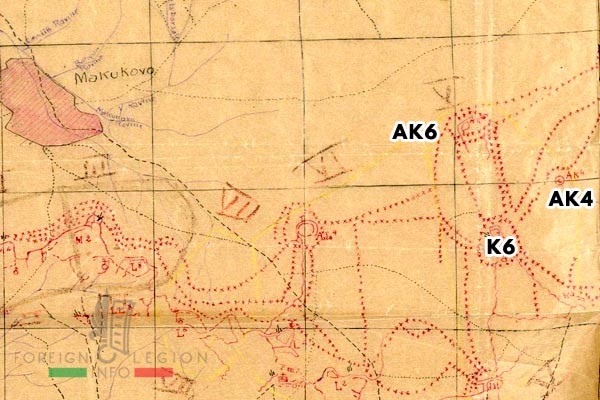

Gorgop and Skra di Legen (April – July 1918)
Rest in Gorgop (April – May 1918)
As of March 19, 1918, the mission in the Karasouli subsector was accomplished. The 1er RMA and the Legion Company were relieved by a British brigade and left to Amatovo (south-east of Karasouli, the village no longer exists today). On March 28, the units had to move via Bohemica to Gorgop (Gorgopi), where the men arrived on March 31. During this movement, a violent snowstorm striked the units; five zouaves were frozen to death.
The legionnaires would set up their camp north of Gorgop. Thereafter, they alternated between training and road (re-)construction works in the region. They would remain there for almost two months.
As of May 24, the 1er RMA left Gorgop. The regiment was ordered to march via Kupa (Koupa) to the sectors of Osin (Archaggelos) and Borislav (Periklia). The Allied troops – three Greek divisions and the 122nd French Division – were preparing a new offensive east of Borislav, in the Skra Di Legen massif. The site had already seen an offensive conducted by the Franco-Greek forces, in May 1917. Nevertheless, the well-entrenched Bulgarians repulsed them.
Skra di Legen (May – July 1918)
While the regiment and the Legion Company were kept behind the front line, the 1er RMA Infantry Gun Platoon was placed at the disposal of the Greek Archipelago Division to support it during the frontal assault.
On May 30, the troops of the Entente attacked the Bulgarian positions, after an immense artillery barrage of the previous day. The enemy’s impressive concrete-built fortifications, a veritable labyrinth equipped with machine guns and numerous lookouts, were removed over a distance of more than 1,650 yards (1,500 m). The Second Battle of Skra di Legen was the very first large-scale participation of Greece in the First World War and, because of it, a glorious victory as well.
The 1er RMA battalions and the Legion Company were following the Greeks. They had to occupy the conquered positions to defend them against a potential counter-offensive.
The Archipelago Division played an essential role in this battle, distinguished for its valor. In addition, the 1er RMA Infantry Gun Platoon, and even the whole regiment were well appreciated by this unit. That’s why on June 2, Colonel Manganaras (the then commander of the Division) mentioned in dispatches at the division level the 1er RMA.
The regiment would remain in the Skra di Legen region to organize the fortified positions. As of July 15, the legionnaires and zouaves were relieved by three battalions of the 16th Colonial Division and the men returned to Gorgop.
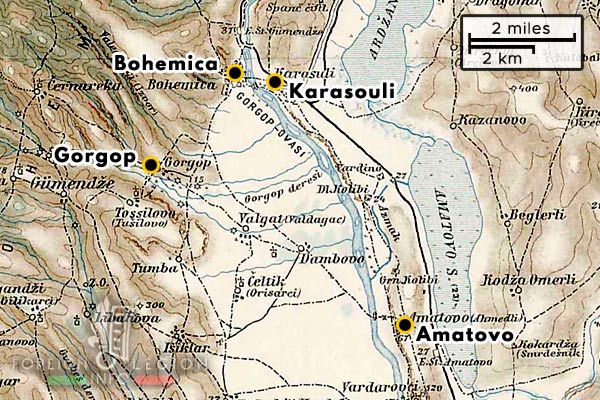
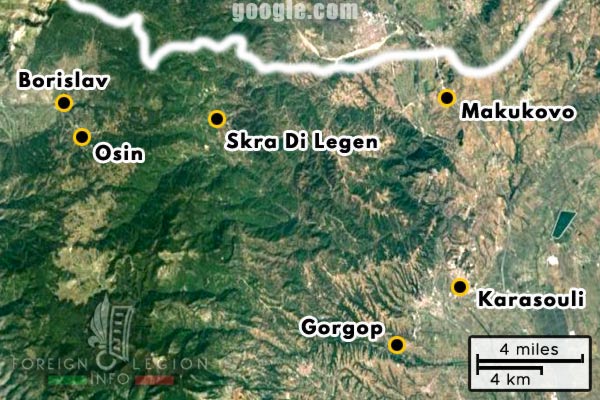
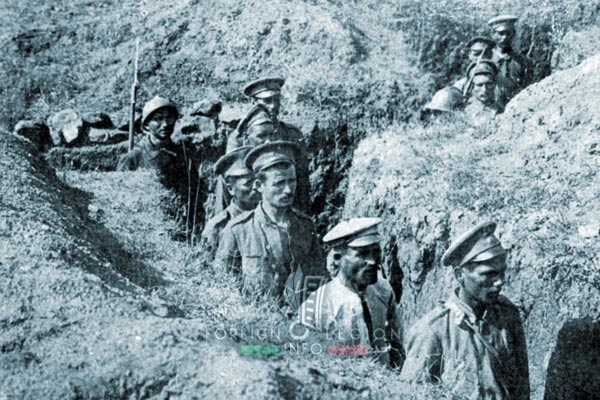
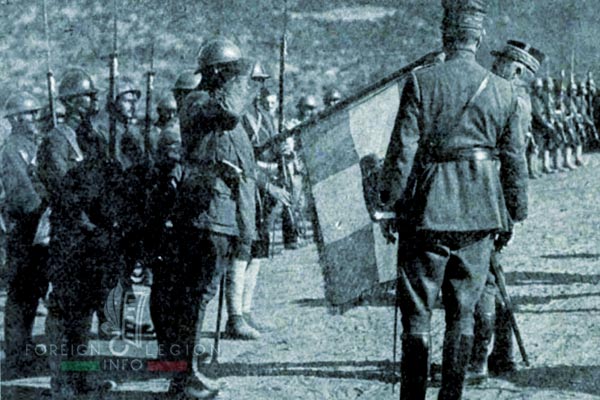
Florina and Monastir (August – September 1918)
In June, General Franchet d’Espèrey became a new commander-in-chief of the Allied Army of the Orient in Salonika. In the summer of 1918, he adopted the plan drawn up by his predecessor and since then, Franchet d’Espèrey had prepared a general offensive against the Bulgarians. He ordered building new roads and railways to enable artillery and ammunition to reach troops along the front. He also launched cartographic surveys and had wired communication networks.
During these preparations, the 1er RMA and the Legion Company were transferred from Gorgop to Florina, well-known to the men from September 1916. Having arrived on July 26, the units spent a few days in Armenohor (Armenochori), a village east of Florina. Thereafter, on July 30, the legionnaires set out for Pisoderi Hill, situated west of Florina.
The next day, the Legion Company was stationed at the village of Pisodéri, which is about 10 miles (17 km) from Florina. The legionnaires, obviously transformed to bâtisseurs (builders), were assigned to French military engineers for road construction projects in the sector.
At the same time, the regiment battalions moved towards Monastir, except for the 1st Battalion (which became temporarily an instruction battalion of the 2nd divisional group) and for the military band; both units were to remain in Florina. The 1er RMA’s HQ set up at Kanina (Kanino, a village south of Monastir), the other two battalions would alternate between Holeven (Oleveni, north of Kanina) and the sectors to the northeast and to the north of Monastir, close to Gorno Orizari and Rastani (Rachtani).
On August 18, Lieutenant Léon and Second Lieutenant Bedel, repatriated, left the Legion Company.
A week later, the 1er RMA again as a whole, except the Legion Company, would move north to be stationed in the so-called Esterel subsector (located between the villages of Rastani and Krklina to the north). The regiment was provisionally assigned to the 76th Division. Two weeks later, on September 6, the 1er RMA changed its designation once again to pass finally under the command of General Borius, commander-in-chief of the 156th Division.
On September 4, the legionnaires left Pisoderi for Velusina (south of Kanina), where they had to stay for eight days of road construction. Afterwards, as of September 13, the Legion Company rejoined the 1er RMA in its subsector. Veterans among the legionnaires could rediscover the positions situated around both Orizari that they were building two years earlier, in late 1916. But this time, the Company would be stationed northwest of Rastani. As usually in those days, they would have to carry out road construction projects to allow artillery batteries to be based in the sector.
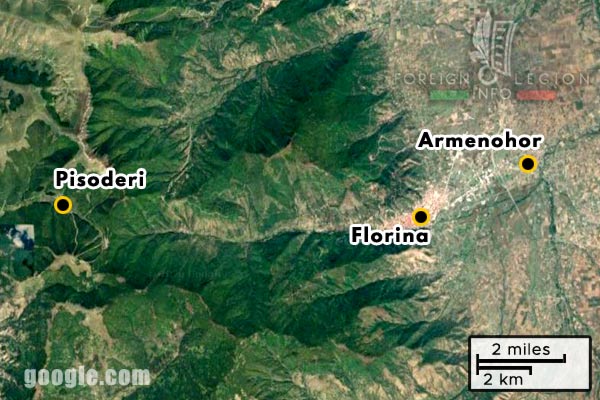
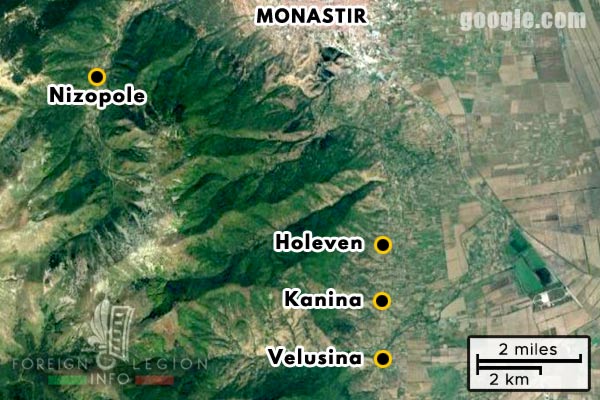
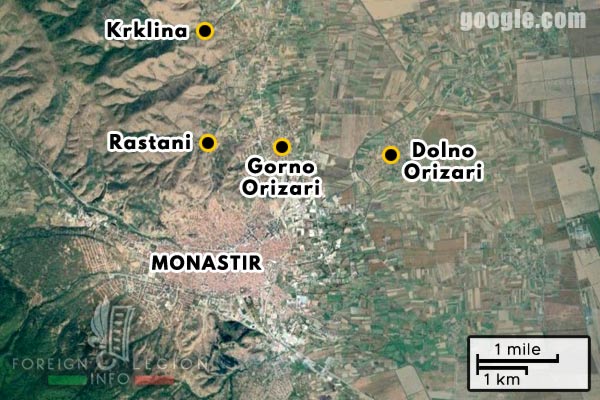
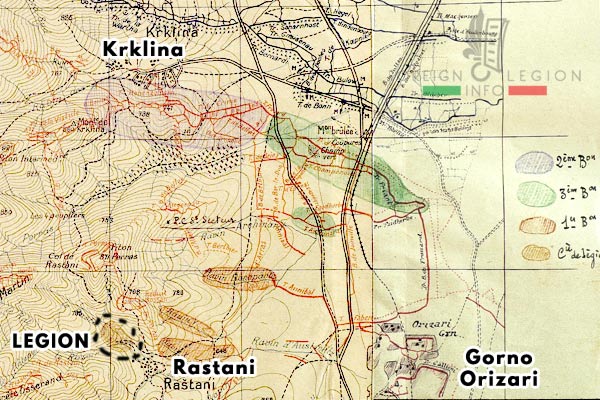
General offensive (end of September 1918)
As of September 14, 1918, General Franchet d’Espèrey ordered the Allied armies to reconquer the Balkans. In the east, British and Greek soldiers launched a frontal assault around Lake Doiran, in the direction of Serbia and Bulgaria. In the middle, the French and the Serbs advancing via Dobro Pole were quickly seizing their objectives.
In the west, there was a series of false attacks in the Monastir region. They were to allow a group of cavalry, composed of two regiments of chasseurs d’Afrique and a regiment of Moroccan spahis, to conduct a maneuver on foot in the direction of Uskub (Skopje, the largest city in Serbia’s Vardar Macedonia and the Central Powers’ military HQ, located 100 km north of Monastir), to capture the city and to cut in half the Bulgarian Army.
Nevertheless, on September 21, after having received news from the front, enemy troops in the Monastir region (Germany’s 11th Army of General von Steuben, composed mostly of Bulgarians commanded by German officers) began a general withdrawal to the north-west, in the direction of Hungary.
The French, supported to the west by Italians (Cagliari Brigade), pursued them. Except the Legion Company remaining at Rastani to complete the road works; the legionnaires didn’t leave the sector until September 27. Meanwhile, at the head of the French column, the 1er RMA came to Cernobok (Crnobuki), where the men fought, on September 24, on the northern heights occupied by the enemy; 4 zouaves were killed and 18 injured. Then, the regiment kept on pursuing the 11th Army to the north-west, having passed through Lisolaj, Vardina, Murgas (Demir Hisar), Pribilci and Dolenci, all the way to Velmevci, where the 1er RMA arrived on the 29th.
The same day, Uskub was successfully captured by the French cavalry. It was a strategic victory. The next day, September 30, 1918, Bulgaria signed an armistice. Bulgarians were now considered prisoners of war.
At the same time, the Legion Company rejoined the rest of the regiment having camped at Velmevci. The units would stay there for another two days. Thereafter, they kept marching towards Kicevo, a city and the center of the region, with a large enemy supply depot. The 1er RMA reached Kicevo on October 4. The Legion Company set up their tents south of the city, at Bigor Dolenci.

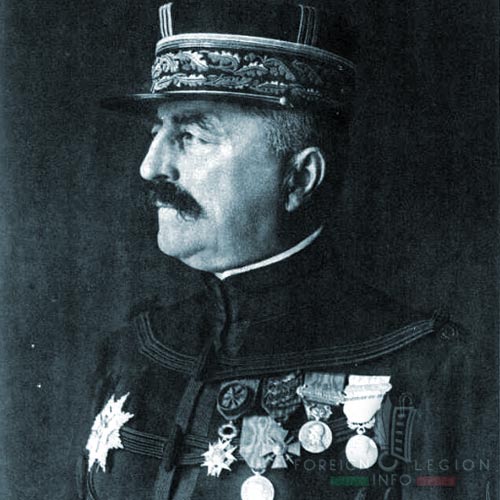
End of the War and return to Salonika (October-December 1918)
First, the legionnaires were ordered to count the enemy materiel seized in Kicevo (machine guns, rifles, transport cars with oxen, etc.) to send it thereafter to French depots. Then, the 1er RMA units, including the Legion Company, were designated to organize in the city the guard and the sorting of the prisoners (Bulgarians of the 11th Army) and their transport from Kicevo to Monastir. The mission would not be accomplished until November 6.
Meanwhile, the Ottoman Empire signed the armistice with the Allies (October 30), followed by Austria-Hungary on November 4.
As of November 7, the 1er RMA and the Legion Company left Kicevo and set out back to Monastir, with a five-day rest at Lisolaj. It is at this village, where the men found out about the Armistice of 11 November 1918 signed by Germany, that ended the First World War.
On November 16, the 1er RMA and the Legion Company left Monastir by rail and were transported to Naoussa, a Greek city halfway between Florina and Salonika. South-east of the city, near the village of Rupan (Stenimachos), the units would take a rest for three weeks, until December 7. The 3rd Battalion of the regiment was definitively disbanded in the meantime, except for the 3e CM.
On December 11, the legionnaires and the zouaves finally reached Salonika and were sent to Camp Franchet d’Espèrey (the former Camp Zeitenlik). But not for long. Two days later, their last mission would begin.
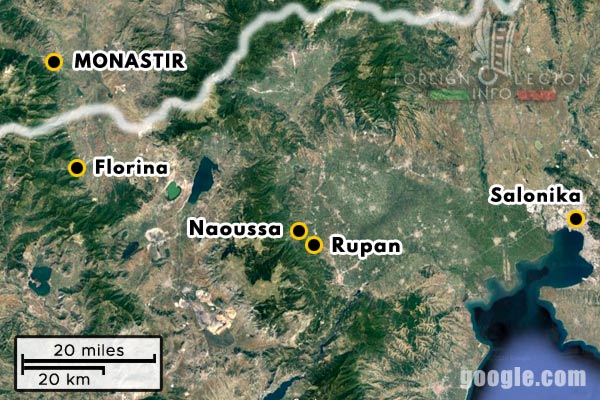
Odessa in Russia (December 1918 – April 1919)
In 1914, the Russian Empire of Tsar Nicholas II went to war against Germany and Austria-Hungary to help Serbia, its ally. The Russians fought with the Germans in East Prussia or with the Turks in the Caucasus. In 1916, four brigades of the Russian Expeditionary Force were formed to deploy to France and to the Salonika front. But the war was very unpopular in Russia and therefore, in March 1917, a revolution flared up. Tsar Nicholas II abdicated. Russia had become a republic, which saw yet another revolution in November. This time, the Bolshevik Revolution. In March 1918, the latter signed peace in Brest-Litovsk with the Germans.
Afterwards, a civil war began in Russia, particularly between the Red Army of the Bolsheviks and the anti-Bolshevik White Armies. An Allied intervention in Russia was therefore organized in 1918. To support the White Army in the south of the country – in the Crimea and in southern Russia (Ukraine today), the French decided to intervene by the Black Sea with forces stationed in Salonika.
On December 13, 1918, the 156th Division, then composed of the 1er RMA (54 officers + 1,650 men) and the 176e RI, embarked and left Salonika for Russia. Two days later, when passing the Gallipoli peninsula, Lt Colonel Geay on board a ship gathered his men and ordered them to pay homage to the dead of the 1er RMA, legionnaires and zouaves, who had fallen at the site in 1915. The few veterans among the men saw once again Morto Bay, Krithia and the ravine of Kérévés Déré.
On December 18, the Division landed in Odessa, a port city in the Black Sea with a strong French influence, and the administrative capital of the region. The city wasn’t yet in the hands of the Bolsheviks. Nevertheless, there was a chaos. For the past four days, the region had been ruled by the Directorate of Ukraine (anti-Bolshevik revolutionary socialists) who replaced the former Hetmanate, an anti-socialist Ukrainian government organized and supported by Germany. German and Austrian troops were still present there, but they had no interest in getting involved in the civil war. There were also escaped White Army members, Ukrainian nationalists or Ukrainian anarchists in Odessa, as well as the Bolsheviks and other political fractions. The situation was very chaotic and sombre.
French units were designated to maintain order there. The 1er RMA was stationed at the Artillery School and would be occupying the city’s two railroad stations and the nearest area. The Legion Company, supported by a machine gun platoon of the 3e CM, had to occupy checkpoints around the cathedral (Cathedral of the Transfiguration). The Company would police there until December 24.
On December 30, after a week spent at the Artillery School, the Legion Company were ordered to protect the local Radio Station. This was the very last mission of the legionnaires sent to Southeastern Europe during WWI.
On January 21, 1919, the 1er RMA, except the legionnaires and the 3e CM, left Odessa for military operations carrying out in the countryside north of the city; the 3e CM rejoined the regiment on February 16. Since that day, the Legion Company had been the only element of the 1er RMA to remain in Odessa.
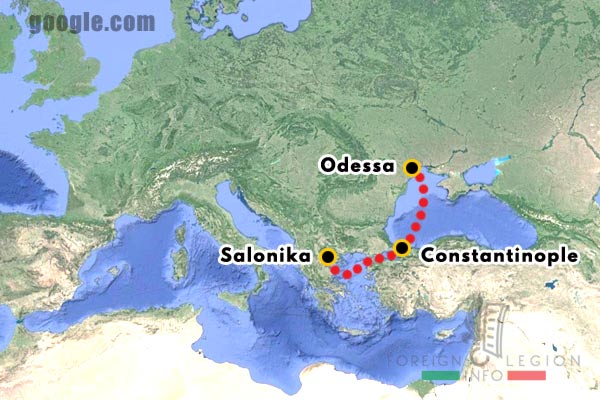
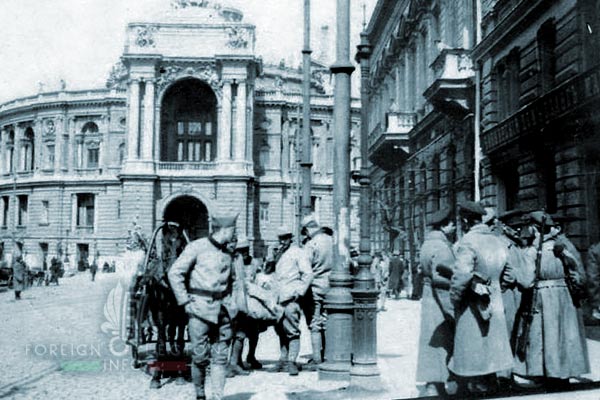
Return from the Balkans and dissolution (April 1919)
In April 1919, the approach of the Red Army, mutinies in the ranks of the White Armies and the hostility of the local population compelled General Franchet d’Espèrey to end the southern intervention and to evacuate the Allied troops (French and Greeks).
On April 2, considerably reduced in the previous months to the strength of only 2 officers, 5 non-commissioned officers and 38 legionnaires under the command of Lieutenant Zanchetta, the Legion Company left Odessa. They would be followed by the rest of the 156th Division on April 6. This day also marks the evacuation of the entire Allied intervention forces and some 50,000 civilians from southern Russia (except for the Crimea).
After a 32-hour stopover in Constantinopole, the legionnaires returned to Salonika.
A week later, on April 14, 1919, the men of the Foreign Legion left definitively the Balkans. They spent four years there, almost to the day. Thirteen officers of the Legion and more than 330 legionnaires had died during the fighting at Gallipoli, in Serbia, in Greece and in Vardar Macedonia. Many others succumbed to their injuries, but also to dysentery or malaria. The latter, in particular, was very serious in the Balkans at the time (30,000 French soldiers were hospitalized with malaria in Greece in 1916).
On April 19, the Legion Company arrived in Tunisia, headed by Lieutenant Zanchetta (an Italian) and Second Lieutenant Papoutzopoulos (a Greek). The legionnaires would stay a few days in Tunisia before being transported by rail to Algeria. On April 26, this small detachment of 45 men arrived in Sidi Bel Abbès and returned to the Quartier Viénot, the then motherhouse of the Foreign Legion. The tormented odyssey of forgotten heroes was over.
As of April 28, 1919, the Foreign Legion Company was dissolved. The fanion, awarded with the War Cross, two mentions in dispatches at the Army level and with the Fourragère, was deposited in the Legion’s Hall of Honor. Having participated in the campaigns more or less ignored in France, the men and their unit would be almost forgotten for the following decades, despite their sacrifice and heroism in hostile countries, far from France.
Conclusion
The 1er RMA remained in Southeastern Europe until June 1919, the month of their dissolution.
Lieutenant Colonel Geay, who came with the Legion in March 1915 to assemble the regiment, he left the 1er RMA in late April 1919. In early 1920, he took command of the 31e RMTA (Algerian Tirailleurs) to participate in an even less known campaign, the Franco-Turkish War (1919-21). Thereafter, with his unit (which had become the 47e RTA in late 1920), he was involved in operations in Lebanon and Syria, until February 1922. Having been promoted to Colonel, he retired from the Army most likely in 1923.
Lastly, to cover all the extensive topic and to prevent some potential confusions, the following notes should be made.
In 1916, an Eastern Legion (Legion d’Orient) was formed with French and some Legion officers and cadres in Egypt, to fight against Ottomans in the Levant. In early 1919, the Legion split up into two formations: Armenian Legion and Syrian Legion. Still with some French/Legion officers and cadres to command them. These units were assigned only for administrative reasons to the Foreign Legion (as did the Greek, Bosnian or Albanian units in the Balkans during WWI), and did not have any real connection to it, apart from the title and the few Legion personnel.
That’s also the case of France’s Foreign Legion North Russia Battalion, a unit consisting of locally recruited anti-Bolshevik auxiliaries led by French officers, some of them coming from the Legion. This battalion was organized in Archangelsk in late 1918 and made part of the Allied North Russia intervention forces. In the manner of the Eastern Legion and the other locally recruited French-led units, even this battalion was administratively assigned to the Foreign Legion’s HQ in Algeria (although there weren’t any pure legionnaire among the men). This is a long-time legal practice issued from the French law.
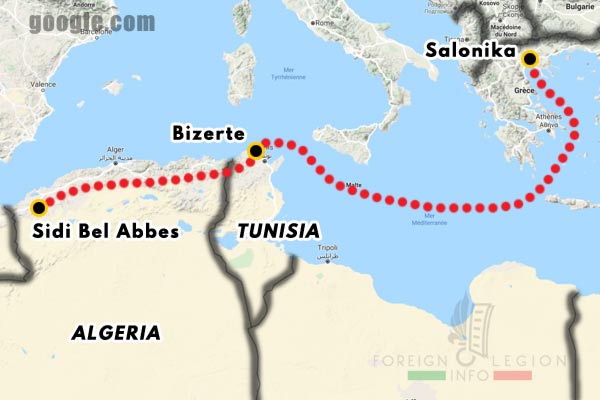

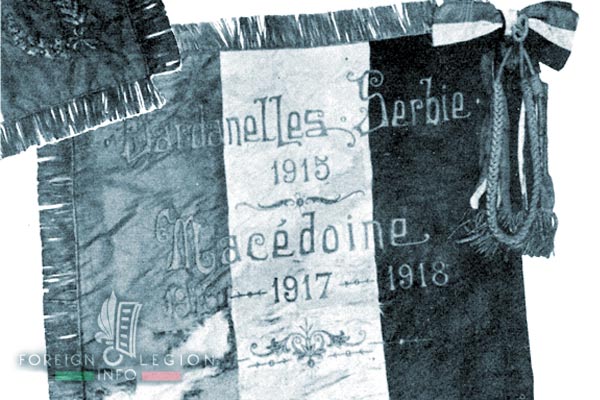

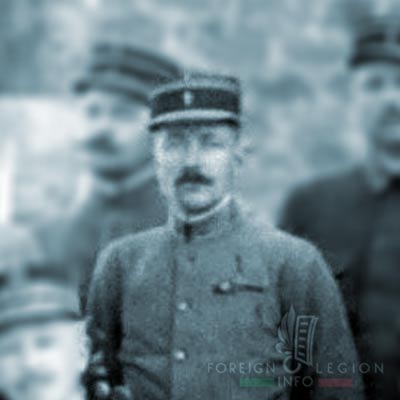
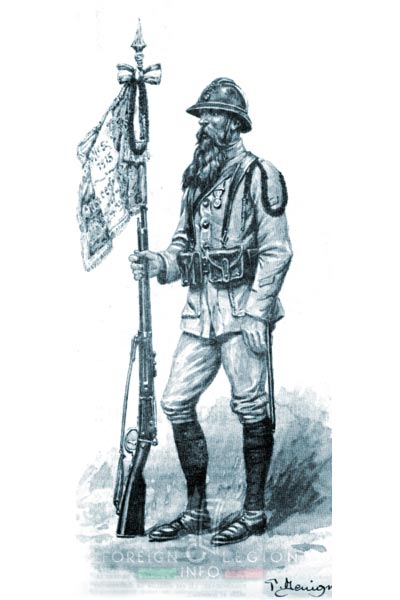
———
Main information & images sources:
War Diary: Foreign Legion Battalion (1915 – 1917)
War Diary: Foreign Legion Company (1917 – 1919)
War Diary: 1er RMA (1915 – 1919)
War Diary: 156th Infantry Division (1915 – 1919)
Képi blanc magazines
Légion Etrangère magazines
L’Illustration magazines
Les tirailleurs (Fr)
Fanion Vert et Rouge (Fr)
Mémorial Gen Web (Fr)
Mémoires des hommes (Fr)
Google Maps
Wikipedia.org
———

You can support this website at any time through our store. Thank you.
EU-based readers can visit our EU-based shop, to avoid import charges.
—
More from the Foreign Legion’s history:
1863 Battle of Camerone
1908 Forthassa Disaster
1932 Turenne Rail Accident
1954 Battle of Dien Bien Phu
1976 Loyada Hostage Rescue Mission
1976 Djibouti helicopter crash
1978 Battle of Kolwezi
1982 Mont Garbi Accident
Foreign Legion Mounted Companies
Foreign Legion Repair Platoons in Africa
6th Foreign Infantry Regiment
11th Foreign Infantry Regiment
—
The page was updated on: May 10, 2020
